Cisco Linksys WPC-V2 Wireless LAN PC Card User Manual WLAN Card Manual
Cisco-Linksys, LLC Wireless LAN PC Card WLAN Card Manual
users manual
PCMCIA 11M
Wireless LAN Card
User Manual
Rev 1.1
Regulatory Compliance
FCC Warning
This equipment has been tested and found to comply with the limits for a Class B digital device, pursuant to part 15 of the FCC Rules. These limits are designed to
provide reasonable protection against harmful interference in a residential installation. This equipment generates, uses and can radiate radio frequency energy and, if not
installed and used in accordance with the instructions, may cause harmful interference to radio communications. However, there is no guarantee that interference will not
occur in a particular installation. If this equipment does cause harmful interference to radio or television reception, which can be determined by turning the equipment off
and on, the user is encouraged to try to correct the interference by one or more of the following measures:
y Reorient or relocate the receiving antenna.
y Increase the separation between the equipment and receiver.
y Connect the equipment into an outlet on a circuit different from that to which the receiver is connected.
y Consult the dealer or an experienced radio/TV technician for help.
You are cautioned that changes or modifications not expressly approved by the party responsible for compliance could void your authority to operate the equipment.
FCC Radiation Exposure Statement
This equipment complies with FCC radiation exposure limits set forth for an uncontrolled environment.
This equipment should be installed and operated with minimum distance 5cm between the radiator & your body.
CE Mark Warning
This is a Class B product. In a domestic environment, this product may cause radio interference, in which case the user may be required to take adequate measures.
About this manual
This manual describes how to install and operate your Wireless LAN card. Please read this manual before you install the product.
This manual includes the following topics:
¾ Product description, features and specifications.
¾ Hardware installation procedure.

Wireless LAN card user manual
ii
¾ Software installation procedure.
¾ Trouble shooting procedures

Preface
iii
Table of contents
CHAPTER 1 .................................................................................................... 1
Introduction 1
Features ............................................................................................... 1
What is Wireless LAN?......................................................................... 1
LAN Modes........................................................................................... 2
Notes on wireless LAN configuration................................................... 2
CHAPTER 2 .................................................................................................... 5
Hardware installation 5
What’s in the package.......................................................................... 5
Hardware description .......................................................................... 5
Inserting the Wireless LAN card .......................................................... 6
Status LEDs.......................................................................................... 7
Ejecting the Wireless LAN card ........................................................... 7
CHAPTER 3 .................................................................................................... 9
Driver installation for Windows and Linux 9
Driver installation for Windows 95...................................................... 9
Driver installation for Windows 98.................................................... 14
Driver installation for Windows 2000................................................ 16
Driver installation for Windows NT 4.0............................................. 20
Driver Installation for Windows ME.................................................. 24
Driver installation for Linux .............................................................. 26
CHAPTER 4 .................................................................................................. 29
Using the Wireless Utility 29
Installation in Windows ..................................................................... 29
Using the Wireless Utility .................................................................. 35
APPENDIX A ................................................................................................ 39
Troubleshooting 39
Q&A for Windows environments........................................................ 39
APPENDIX B................................................................................................. 41
Specifications ..................................................................................... 41

1
Chapter 1
Chapter 1Chapter 1
Chapter 1
Introduction
Thank you for purchasing the Wireless LAN card. This high-speed Wireless LAN card provides you with an innovative wireless networking solution. The Card is easy to
set up and use. With this innovative wireless technology, you can share files and printers on the network—without inconvenient wires! Now you can carry the LAN in
your pocket!
Features
• Wire-free access to networked resources from anywhere beyond the desktop
• Low interference & high susceptibility guarantee reliable performance
• Delivers data rate up to 11 Mbps
• Dynamically shifts between 11, 5.5, 2, and 1 Mbps network speed, based on signal strength, for maximum availability and reliability of connection
• Allows users move between Access Points without resetting their connection reconfiguration
• Antenna is built in to the card with LEDs indicating Power and Link
• Uses 2.4GHz frequency band, which complies with worldwide requirement
• Supports most popular operating systems: Window 95/98/2000/NT 4.0/ME and Linux
• Ensures great security by providing the Wired Equivalent Privacy (WEP) defined in the IEEE 802.11 standard
What is Wireless LAN?
Wireless Local Area Network (WLAN) systems offer a great number of advantages over traditional wired systems. WLANs are flexible and easy to setup and
manage. They are also more economical than wired LAN systems.
Using radio frequency (RF) technology, WLANs transmit and receive data through the air. WLANs combine data connectivity with user mobility. For example,
users can roam from a conference room to their office without being disconnected from the LAN.
Using WLANs, users can conveniently access shared information, and network administrators can configure and augment networks without installing or moving
network cables.
WLAN technology provides users with many convenient and cost saving features:
• Mobility: WLANs provide LAN users with access to real-time information anywhere in their organization, providing service opportunities that are impos-
sible with wired networks.
• Ease of Installation: Installing is easy for novice and expert users alike, eliminating the need to install network cables in walls and ceilings.

Wireless LAN card user manual
2
• Scalability: WLANs can be configured in a variety of topologies to adapt to specific applications and installations. Configurations are easily changed and
range from peer-to-peer networks suitable for a small number of users to full infrastructure networks of thousands of users roaming over a broad area.
LAN Modes
Wireless LANs can be configured in one of two ways:
Ad-hoc
Networking
Also known as a peer-to-peer network, an ad-hoc net-
work is one that allows all workstations and computers
in the network to act as servers to all other users on
the network. Users on the network can share files,
print to a shared printer, and access the Internet with a
shared modem. However, with ad-hoc networking,
users can only communicate with other wireless LAN
computers that are in the wireless LAN workgroup, and
are within range.
Infrastructure
Networking
Infrastructure networking differs from ad-hoc network-
ing in that it includes an access point. Unlike the ad-
hoc structure where users on the LAN contend the
shared bandwidth, on an infrastructure network the
access point can manage the bandwidth to maximize
bandwidth utilization.
Additionally, the access point enables users on a
wireless LAN to access an existing wired network, al-
lowing wireless users to take advantage of the wired
networks resources, such as Internet, email, file
transfer, and printer sharing.
Infrastructure networking has the following advantages
over ad-hoc networking:
• Extended range: each wireless LAN computer
within the range of the access point can commu-
nicate with other wireless LAN computers within
range of the access point.
• Roaming: the access point enables a wireless
LAN computer to move through a building and
still be connected to the LAN.
• Wired to wireless LAN connectivity: the access
point bridges the gap between wireless LANs and
their wired counterparts.
Notes on wireless LAN configuration
When configuring a wireless LAN (WLAN), be sure to note the following points:

—Introduction
3
• Optimize the performance of the WLAN by ensuring that the distance between access points is not too far. In most buildings, WLAN cards operate within a
range of 100 ~ 300 feet, depending on the thickness and structure of the walls.
• Radio waves can pass through walls and glass but not metal. If there is interference in transmitting through a wall, it may be that the wall has reinforcing
metal in its structure. Install another access point to circumvent this problem.
• Floors usually have metal girders and metal reinforcing struts that interfere with WLAN transmission.
This concludes the first chapter. The next chapter deals with the hardware installation of the Wireless LAN card.

5
Chapter 2
Chapter 2Chapter 2
Chapter 2
Hardware installation
This chapter covers inserting your Wireless LAN card in the PCMCIA slot of notebook, and connecting the card to a network.
What’s in the package
Please ensure that the following items are included in your package. If any items are missing, contact your dealer.
• Wireless LAN PCMCIA card
• CD-ROM (includes utility, drivers, and this manual)
• Quick installation guide
Hardware description
The Wireless LAN Card is encased in a stainless compact frame and has a 68-pin connector for attaching to the PCMCIA port of notebook.
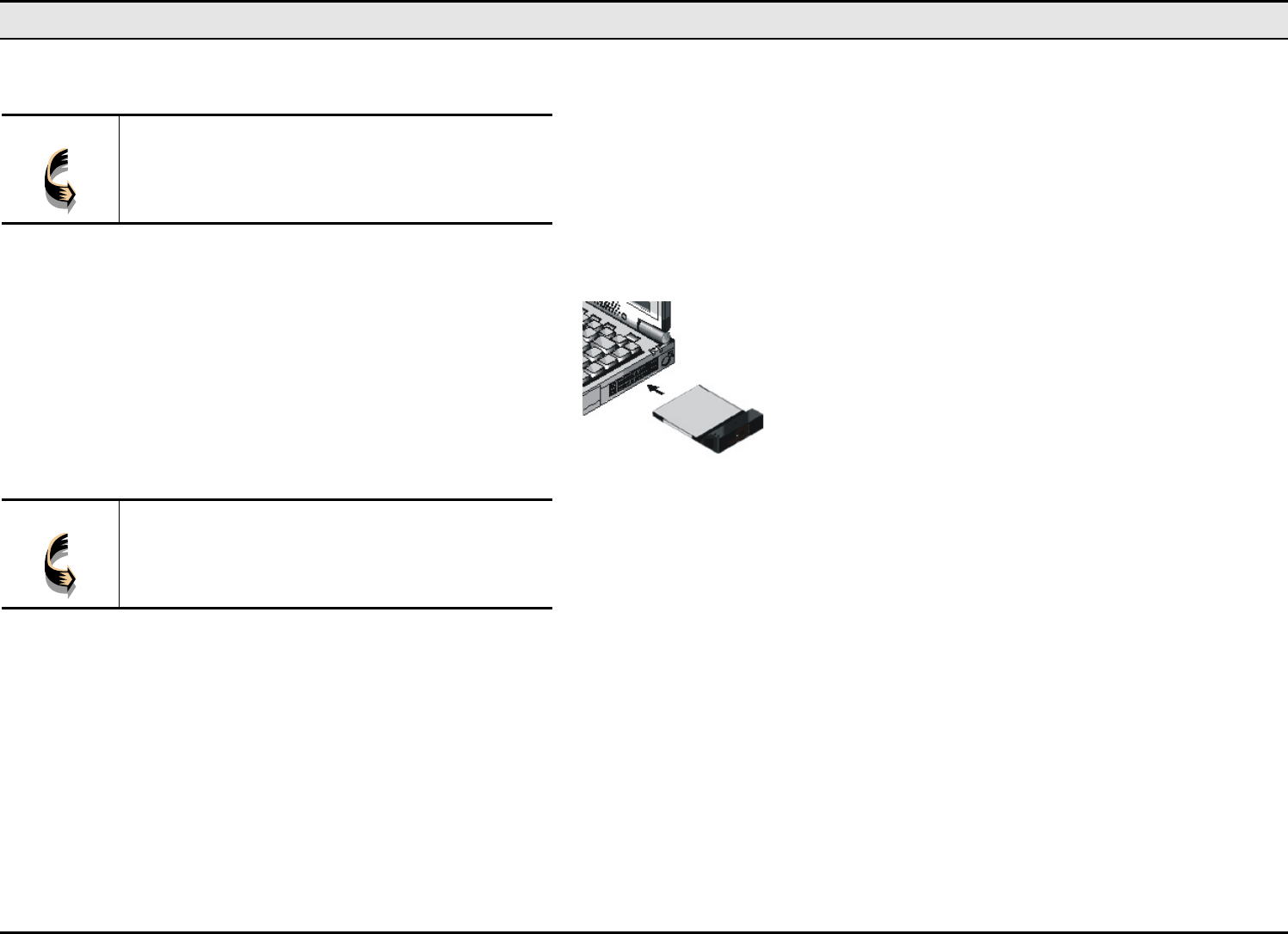
Wireless LAN card user manual
6
Inserting the Wireless LAN card
Note! These instructions apply to most notebook computers.
For detailed information on inserting PC cards into
your notebook, consult the notebook manual.
Follow the procedure below to install the Wireless LAN card.
1. With 68-pin connector of the card facing the PCMCIA slots on notebook, slide the card all the way into an empty slot.
2. Connect to a network.
Note! For information on connecting your Card to the LAN,
contact your system administrator.
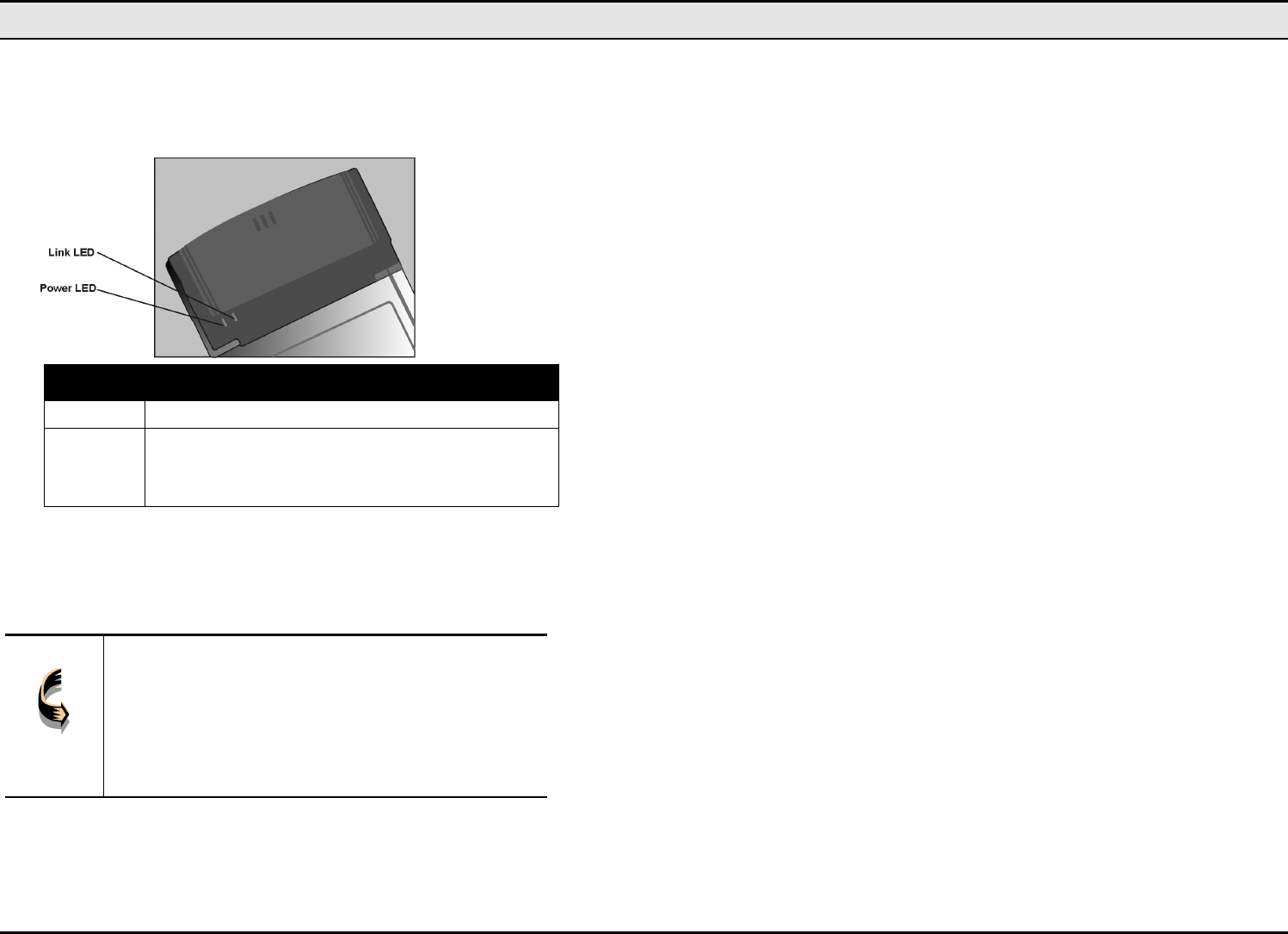
—Hardware installation
7
Status LEDs
The following table describes the meaning of the LEDs:
LED MEANING
PWR Indicates that the Card is powered on.
LINK Indicates link status. It is normally blinking. When blink-
ing, indicates that the card is scanning the channels, and
the link is not active. When lit, indicates that the card is
locked to a channel, and the link is active.
Ejecting the Wireless LAN card
After disconnecting from the LAN, you can eject the Wireless LAN card from the PC Card slot of notebook.
Note! In Win 2000/ME/98/95 operating systems, you do not have
to power down the notebook to remove the card. The card
is hot-swappable—you can remove the card when the
notebook is powered on. However, Microsoft recommends
that you stop the card. Refer to your Windows
2000/ME/98/95 online help for information on stopping the
Wireless LAN card.
Most notebooks have an eject lever or button for ejecting PC cards from the PC slots. Consult your notebook manual for details.
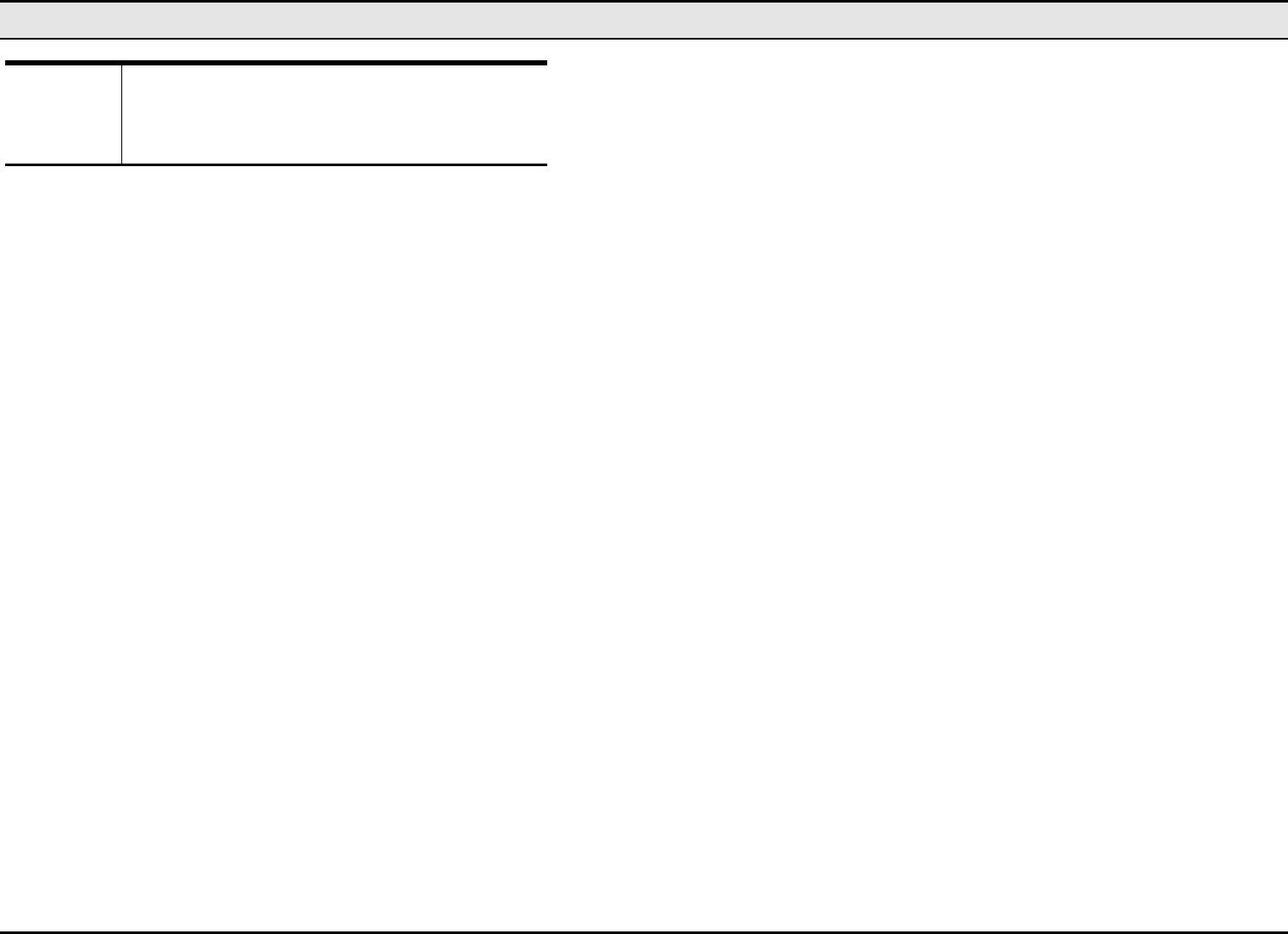
Wireless LAN card user manual
8
Warning! To prevent data loss, do not eject the Wireless LAN card
when a data transmission is taking place. Exit your commu-
nications program normally, stop the card if necessary, and
then remove the card.
This concludes Chapter 2. The next chapter covers driver installation for Windows 2000/ME/98/95/NT and Linux operating systems.
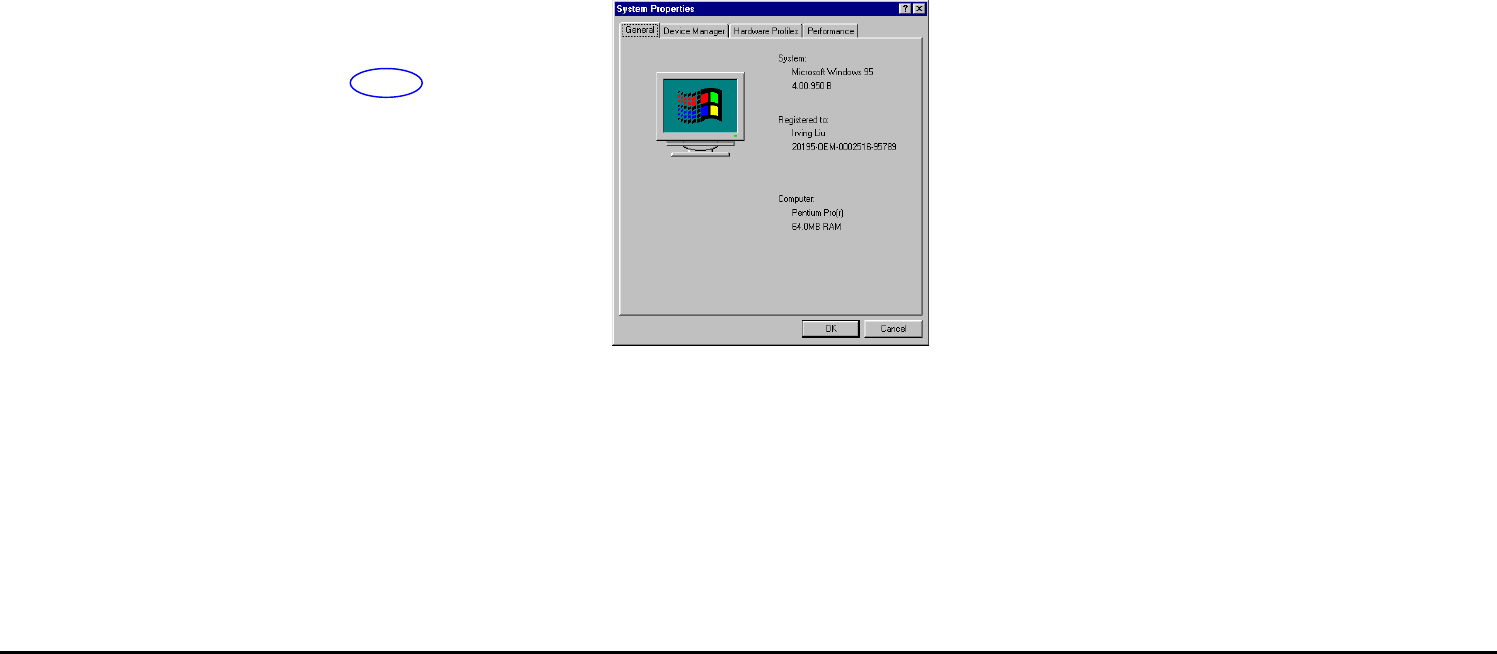
9
Chapter 3
Chapter 3Chapter 3
Chapter 3
Driver installation for Windows and Linux
The following sections cover Wireless LAN card driver installation in the Windows 2000/ME/98/95/NT operating systems.
Driver installation for Windows 95
There are two popular versions of Windows 95, one is for retail version (ver 4.00.950), and the other is OEM Service Release 2 (ver 4.00.950B). To know which
version you are using, click to run the System icon in Control Panel. You will see the following window pops up.
From the General tab, the system information shows you the version number of your windows.
Install Drivers on the Windows 95 OSR2
1. Insert the Wireless LAN card into an available PCMCIA slot in your notebook (refer to page 6 - Inserting the wireless LAN card).
2. After Windows 95 detects the card, the Update Device Driver Wizard window appears:
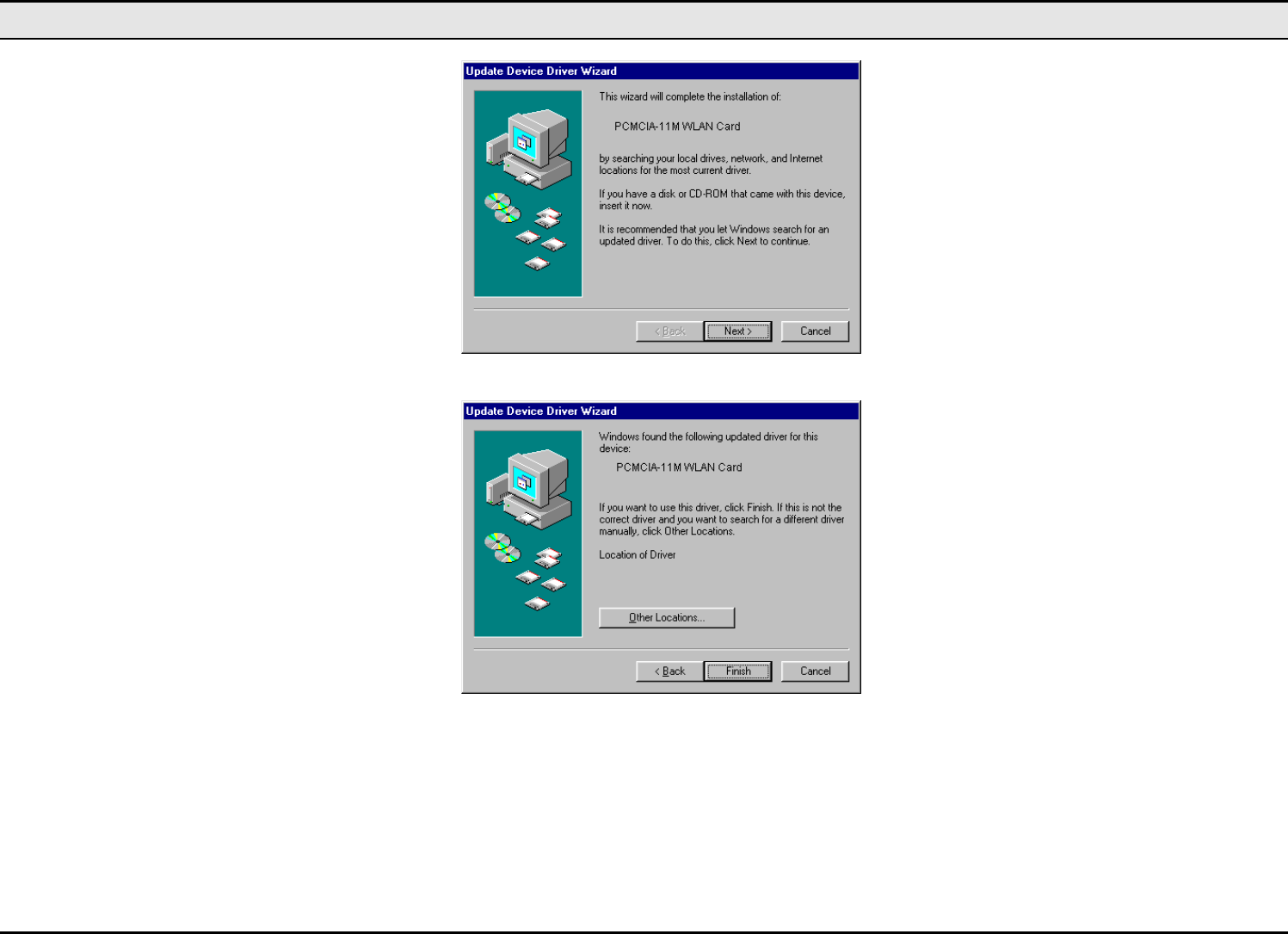
Wireless LAN card user manual
10
3. Insert the driver disc and click Next to continue the installation. Windows searches for the driver and the following screen appears:
4. Click Other Locations to bring up the following window:
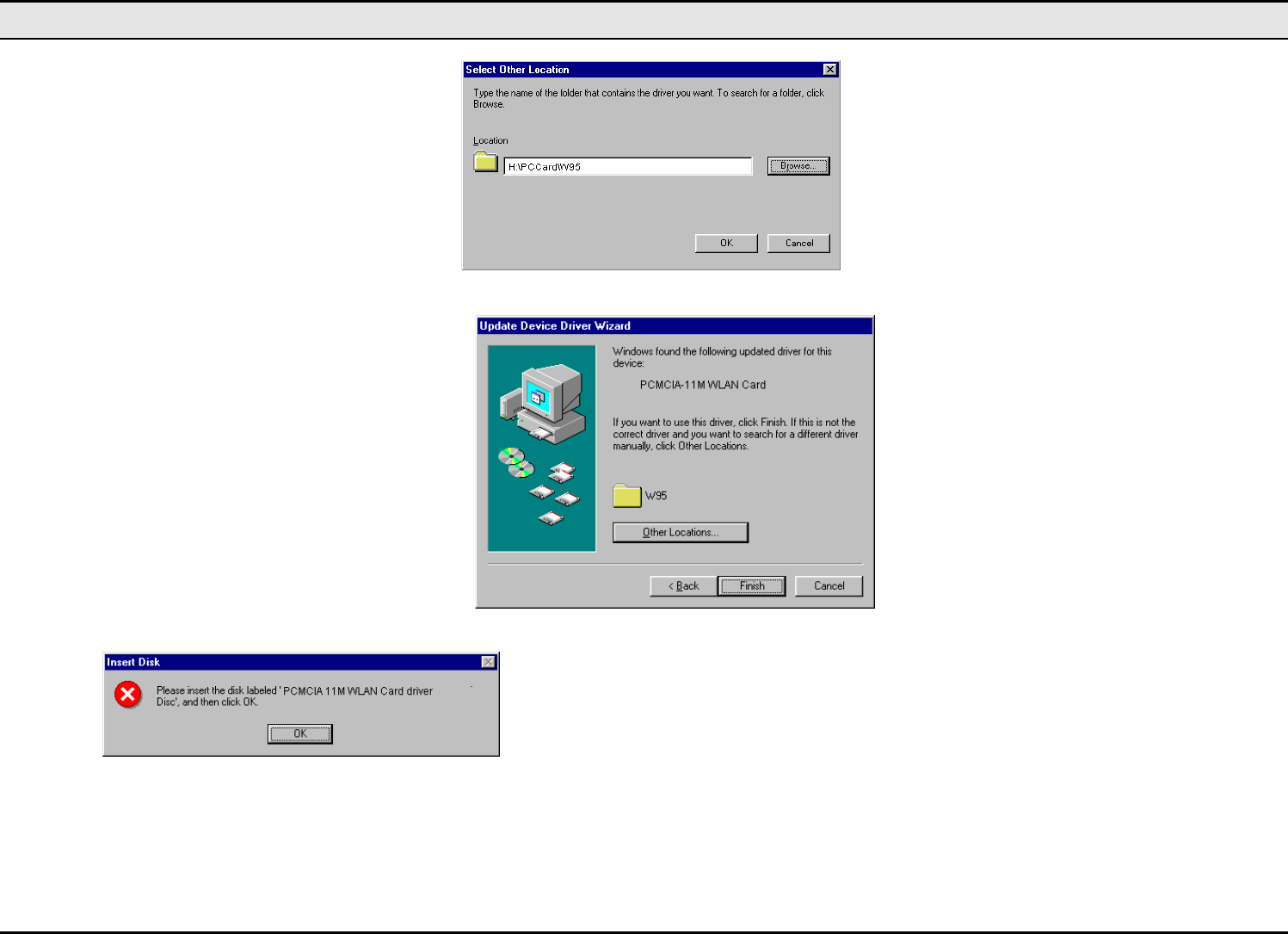
—Driver installation for Windows and Linux
11
5. Type H:\PCCard\W95 where H is your CD-ROM drive letter. Then click OK. The following screen appears:
6. Click Finish to continue. Windows may prompt you the following window to ask you insert the disc.
7. Click OK to continue.
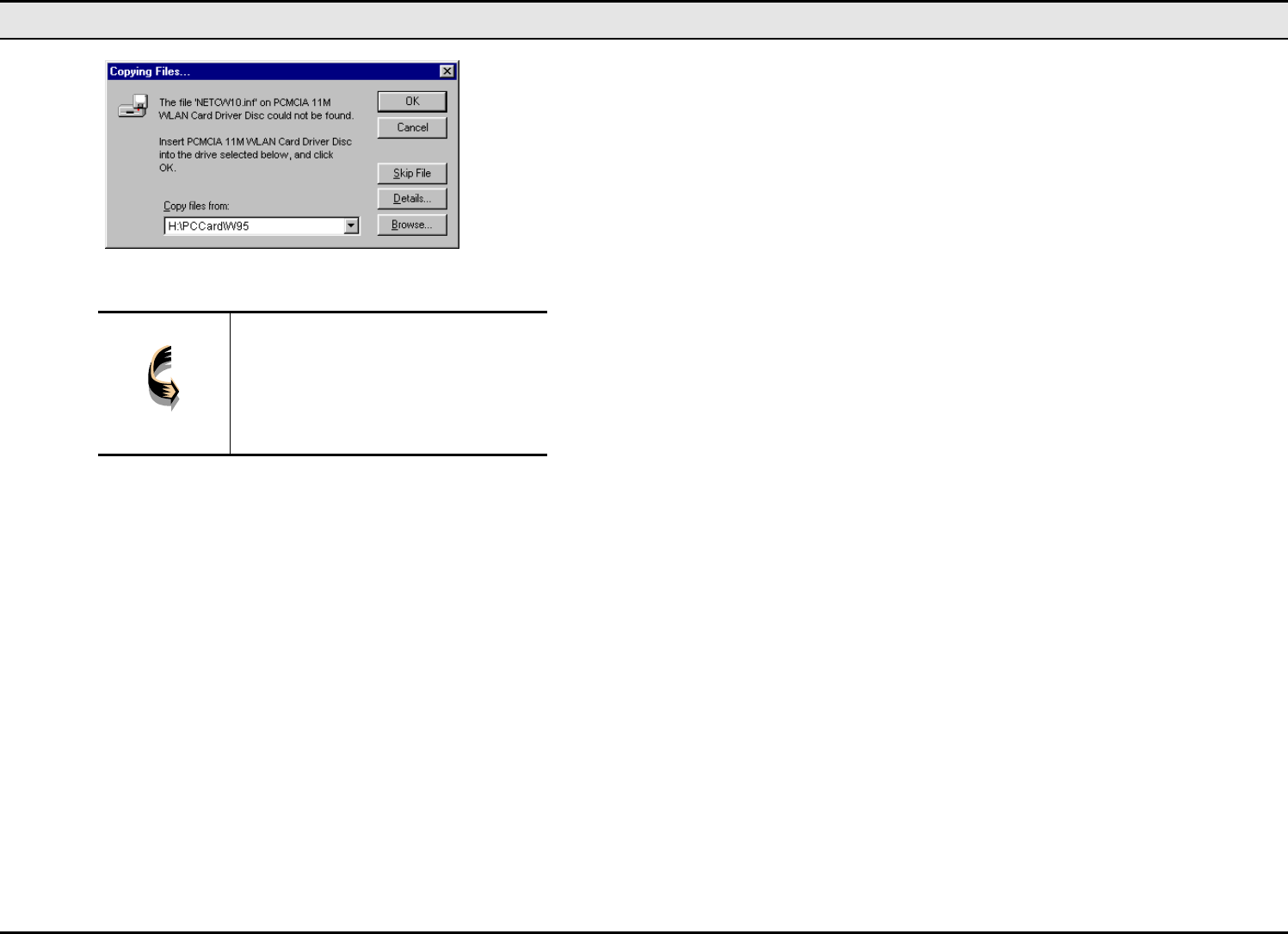
Wireless LAN card user manual
12
8. Again type H:\PCCard\W95 where H is your CD-ROM drive letter and click OK. After copying the driver files. Windows 95 prompts you to restart the
system. Click Yes to continue the installation.
Note! If you did not install the Windows 95
OSR2 from your hard drive, Windows
will prompt you to input the path to the
Windows 95 CD-ROM. Follow the in-
structions on your screen, then click
OK to continue.
9. After you rebooted the computer, system will start to install wireless utility automatically. Please refer to procedures at Chapter 4.
Install Drivers on the Windows 95 Retail version
1. Insert the LAN Modem card into an available PCMCIA slot in your notebook (refer to page 6 - Inserting the LAN Modem card).
2. After Windows 95 detects the card, the Update Device Driver Wizard window appears:
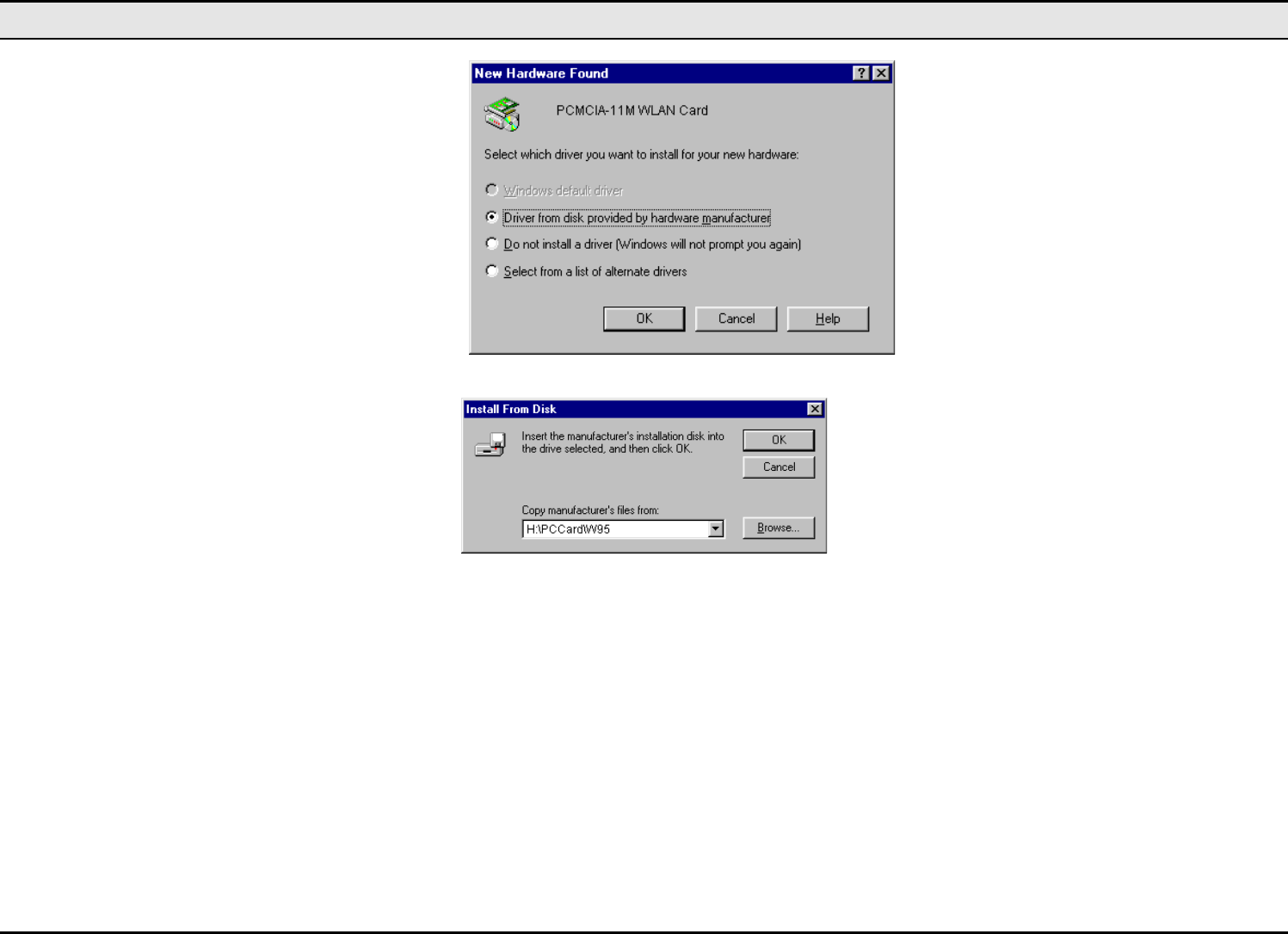
—Driver installation for Windows and Linux
13
3. Click OK. The Windows prompt you to give the path of driver files.
4. Type H:\PCCard\W95 where H is your CD-ROM drive letter. Insert the driver disc into CD-ROM drive. Then click OK.
5. The windows will start copying files from disc and install the drivers. After the step, the installation is complete and you should reboot the system.
After you rebooted the computer, system will start to install Wireless utility automatically. Please refer to procedures at Chapter 4.
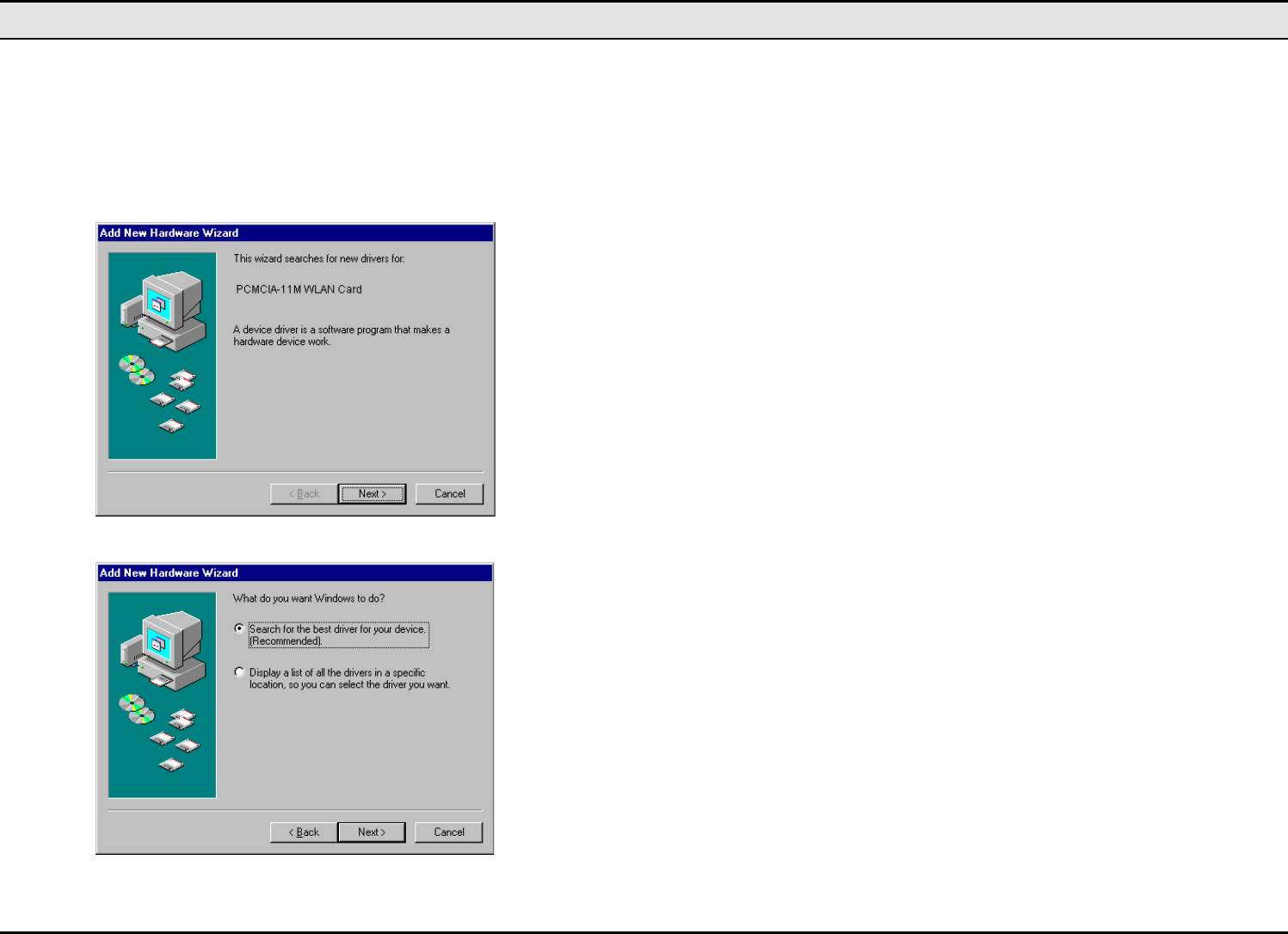
Wireless LAN card user manual
14
Driver installation for Windows 98
Follow the steps below to install the Wireless LAN card drivers for Windows 98.
1. Insert the Wireless LAN card into an available PCMCIA slot on your notebook (refer to page 6 - Inserting the Wireless LAN card).
2. After Windows 98 detects the Wireless LAN card, the Add New Hardware Wizard window appears:
3. Click Next to continue the installation. A screen appears prompting you to select an installation method:
4. Select Search for the best driver for your device. (Recommended) and click Next. The following screen appears:
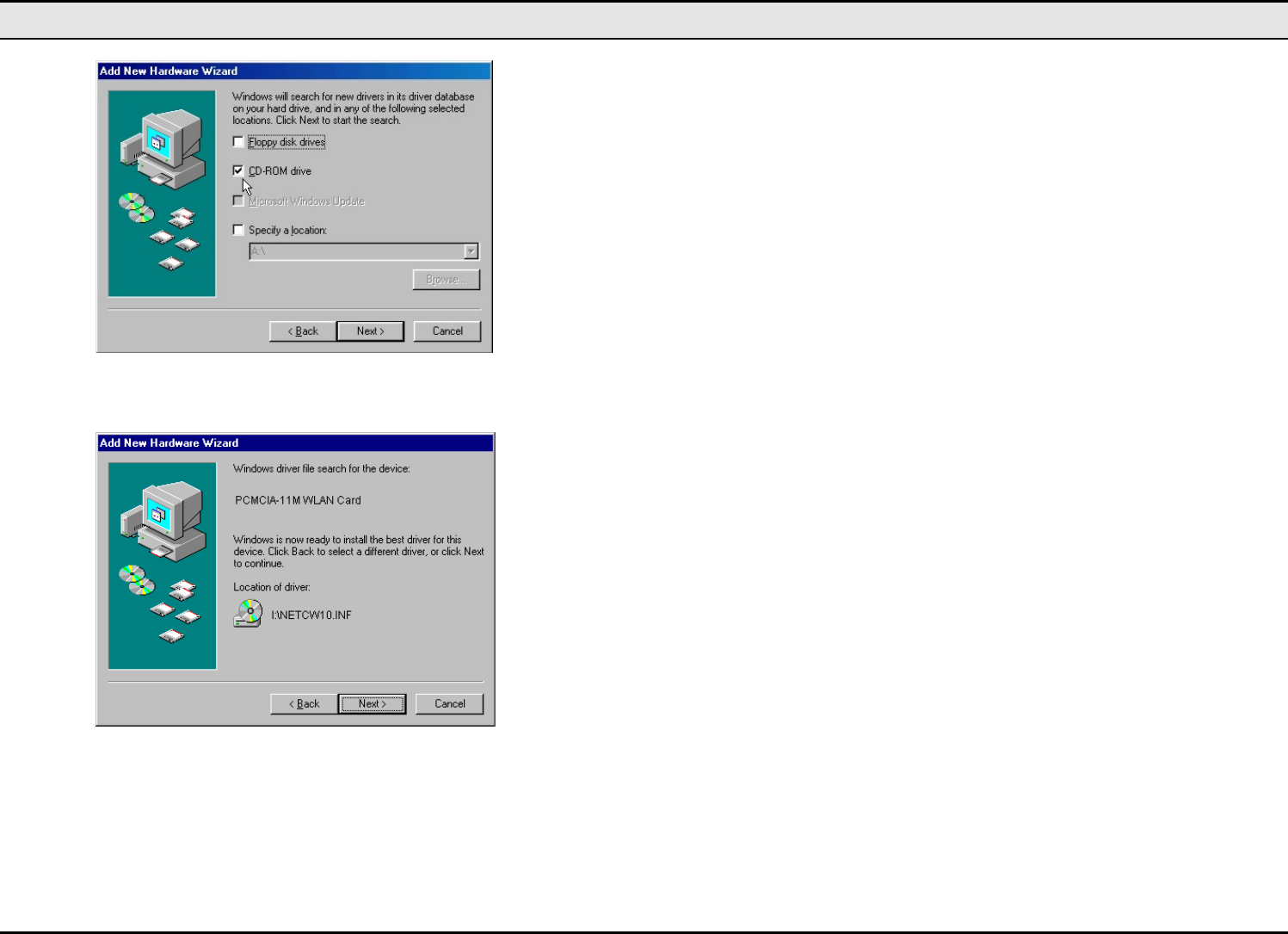
—Driver installation for Windows and Linux
15
5. Ensure that the CD-ROM drive box is checked.
6. Insert the driver CD-ROM into your CD-ROM drive and click Next. The following screen appears:
7. Click Next. Windows 98 copies files to your hard disk drive, and you see the following screen:
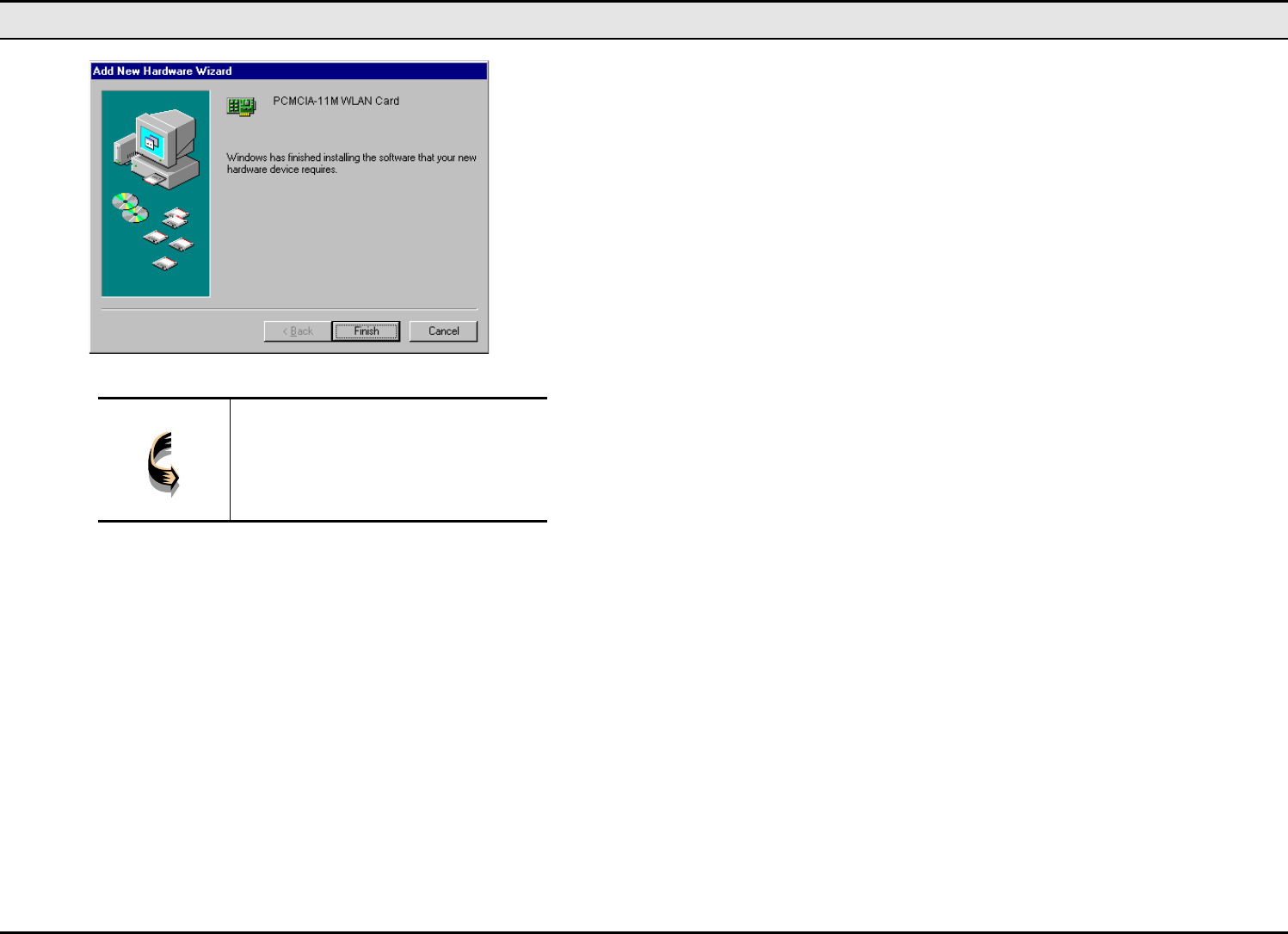
Wireless LAN card user manual
16
8. Click Finish. You should reboot your system to finish the installation.
Note! Windows 98 may need to copy re-
quired system files and will prompt you
to input the path to the files. Follow the
instructions on your screen, and then
click OK to continue.
After you have rebooted the computer, system will start to install Wireless utility automatically. Please refer to procedures at Chapter 4.
Driver installation for Windows 2000
Follow the steps below to install the Wireless LAN card drivers for Windows 2000.
1. Insert the Wireless LAN card into an available PCMCIA slot on your notebook (refer to page 6 - Inserting the Wireless LAN card).
2. After Windows 2000 detects the Wireless LAN card, the Found New Hardware Wizard window appears:
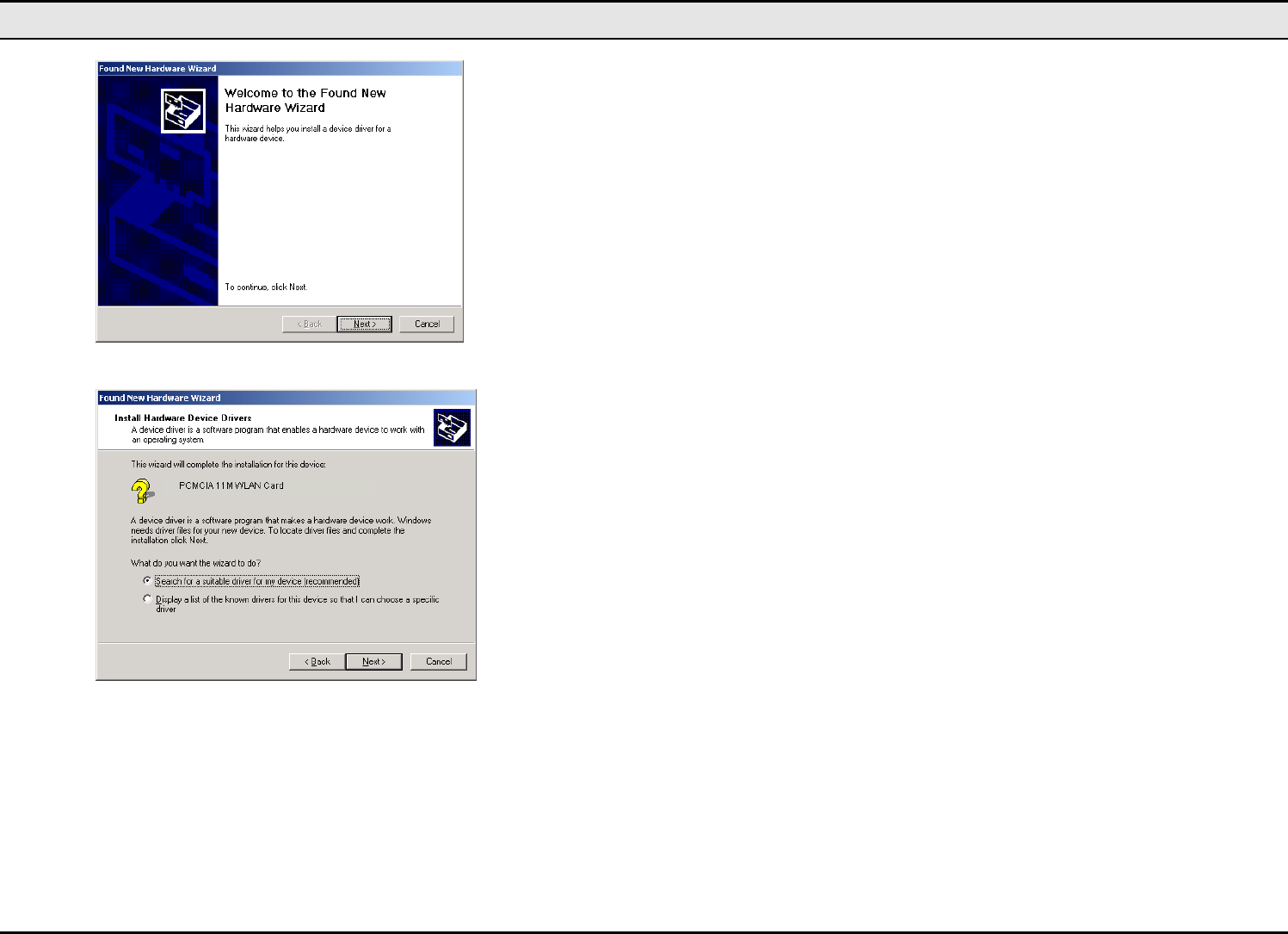
—Driver installation for Windows and Linux
17
3. Click Next to continue the installation. A screen appears prompting you to select an installation method:
4. Select Search for a suitable driver for my device (recommended) and click Next. The following screen appears:
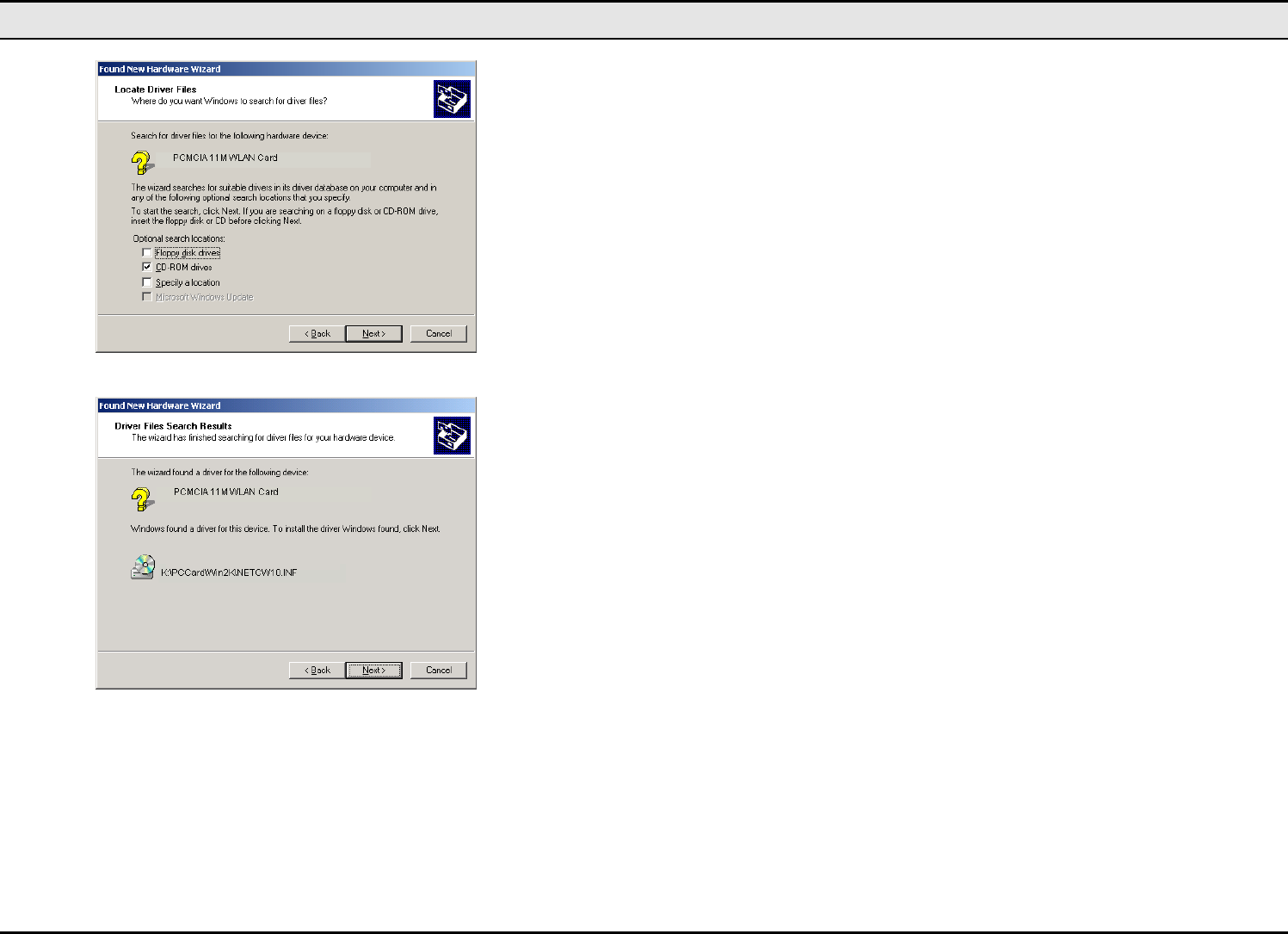
Wireless LAN card user manual
18
5. Ensure that the CD-ROM drivers box is checked and insert the driver disc into CD-ROM drive. Click Next to continue. The following screen appears:
6. Click Next to continue. The following screen appears:
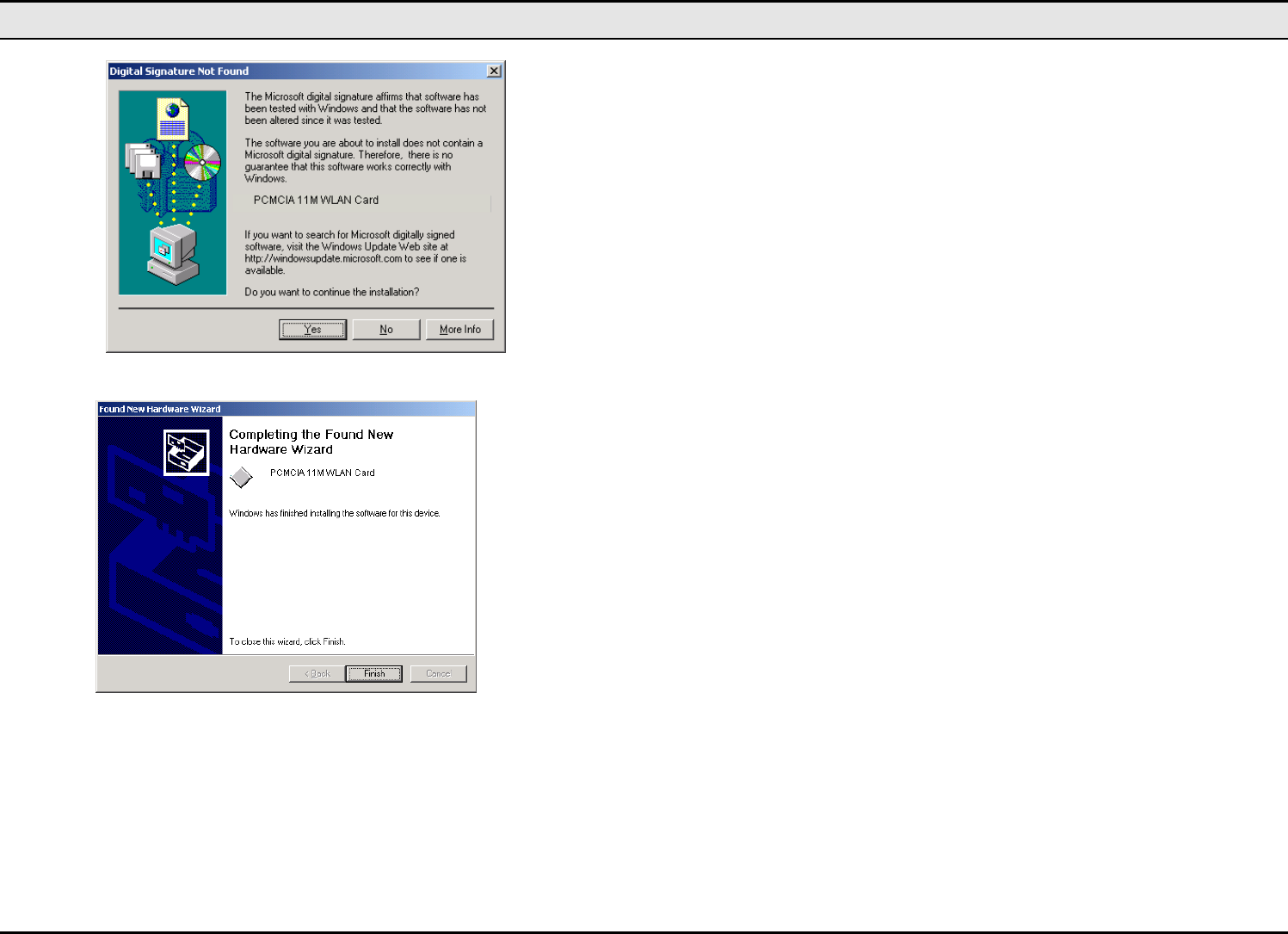
—Driver installation for Windows and Linux
19
7. Click Yes to continue. The following screen appears:
8. Click Finish to complete the installation.
9. Then system will start to install Wireless utility automatically. Please refer to procedures at Chapter 4.
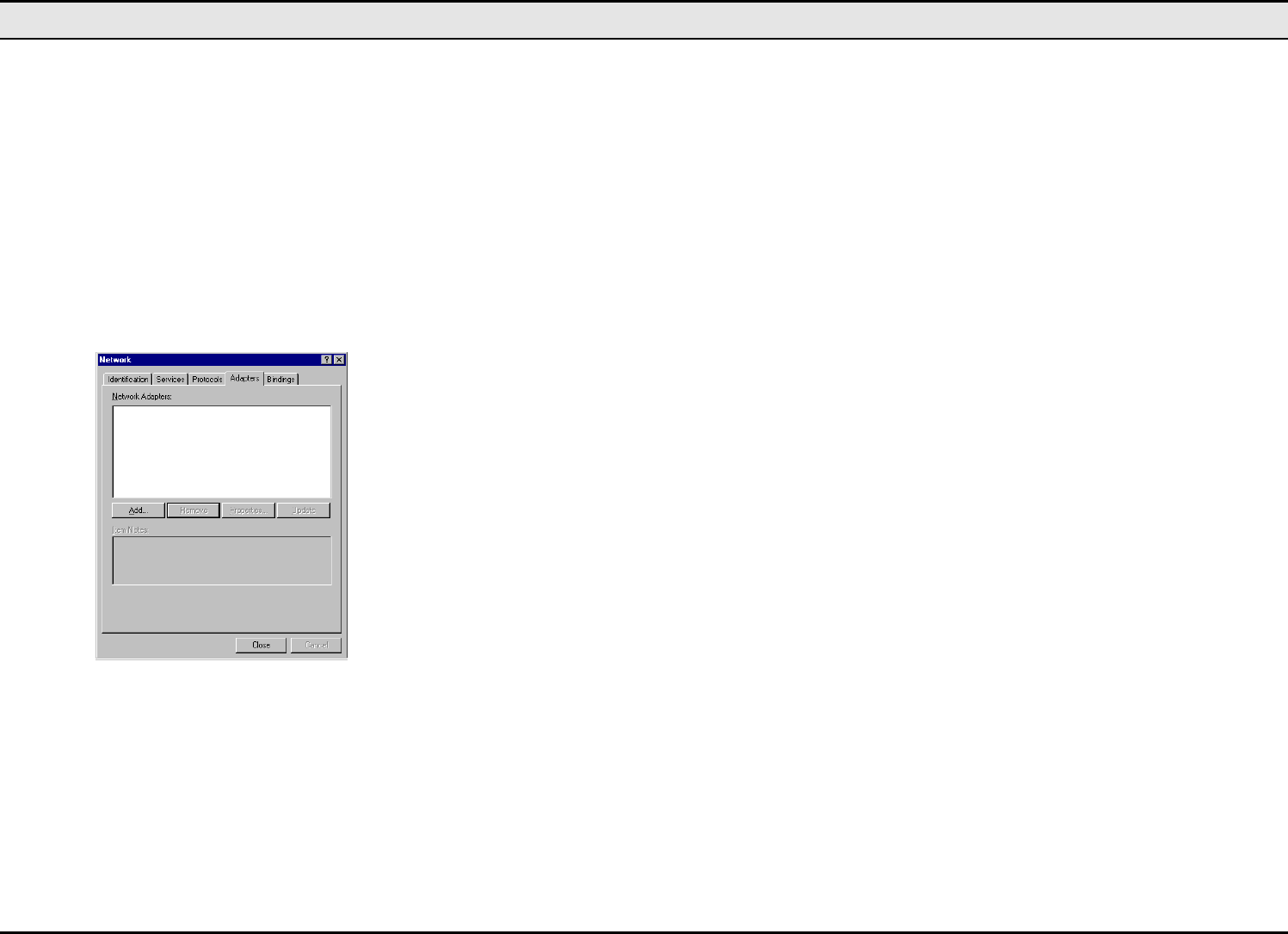
Wireless LAN card user manual
20
Driver installation for Windows NT 4.0
This installation procedure assumes that you have installed the network component on your computer.
To check whether the network component has been installed, double click the Network icon in the Control Panel. If it has not been installed, refer to the Win-
dows NT 4.0 installation guide for instructions on installing the component.
Follow the steps below to install the driver.
1. Insert the Wireless LAN card into an available PCMCIA slot on your notebook (refer to page 6 - Inserting the Wireless LAN card).
2. Log in to NT 4.0 as Administrator.
3. Double click the Network icon in the Control Panel, and select the Adapters tab as shown in the following screen:
4. Click Add to add a new adapter. The following screen appears:
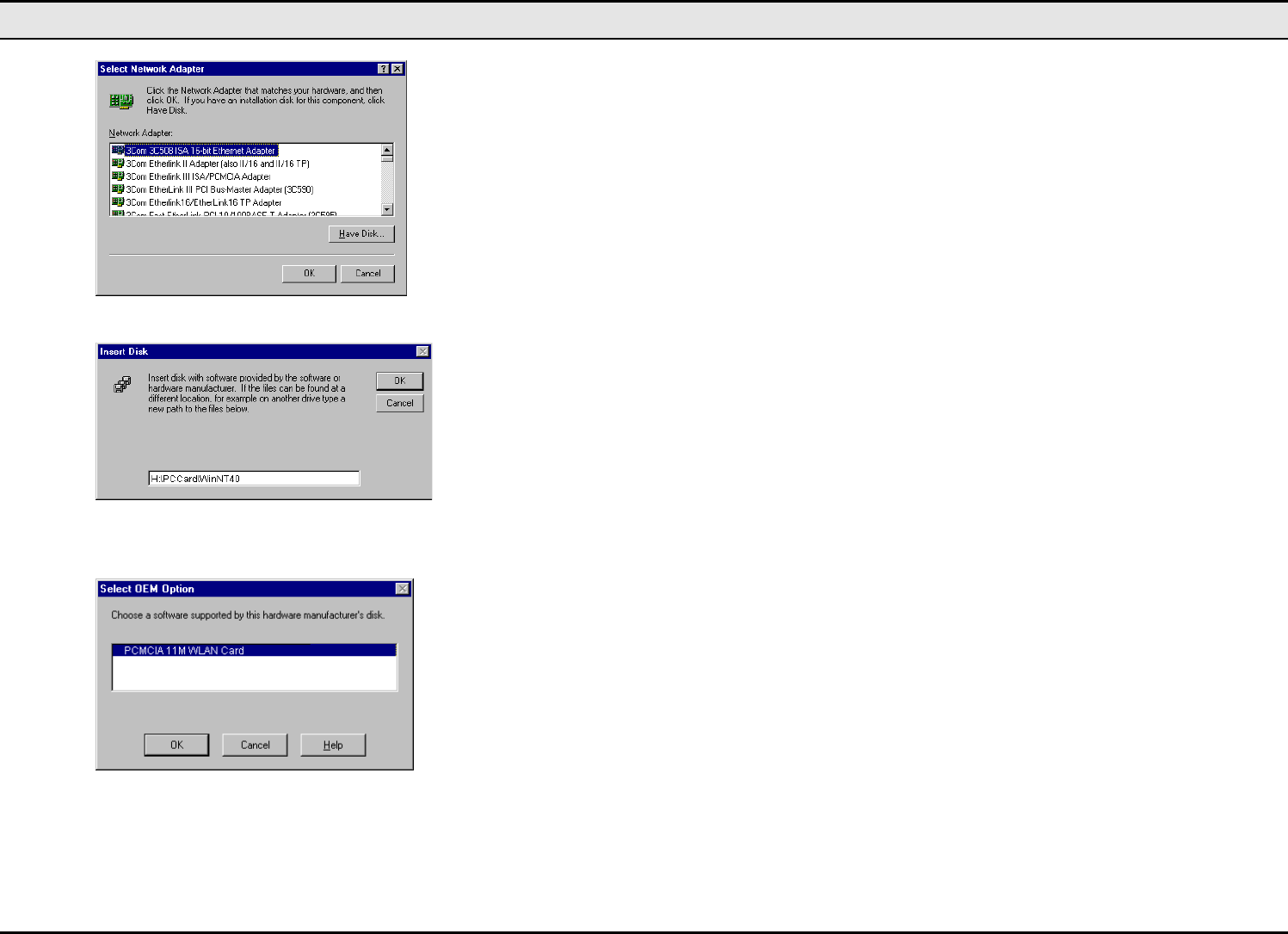
—Driver installation for Windows and Linux
21
5. Click Have Disk. The following screen appears:
6. Type H:\PCCard\WinNT40 where H is your CD-ROM drive letter. Insert the driver disk, and click OK.
After finding the installation file, the Select OEM Option window is displayed.
7. Click OK. A screen appears prompting you to input the IRQ, I/O port address, SSID, mode, transfer rate, and channel, as well as some advanced settings:
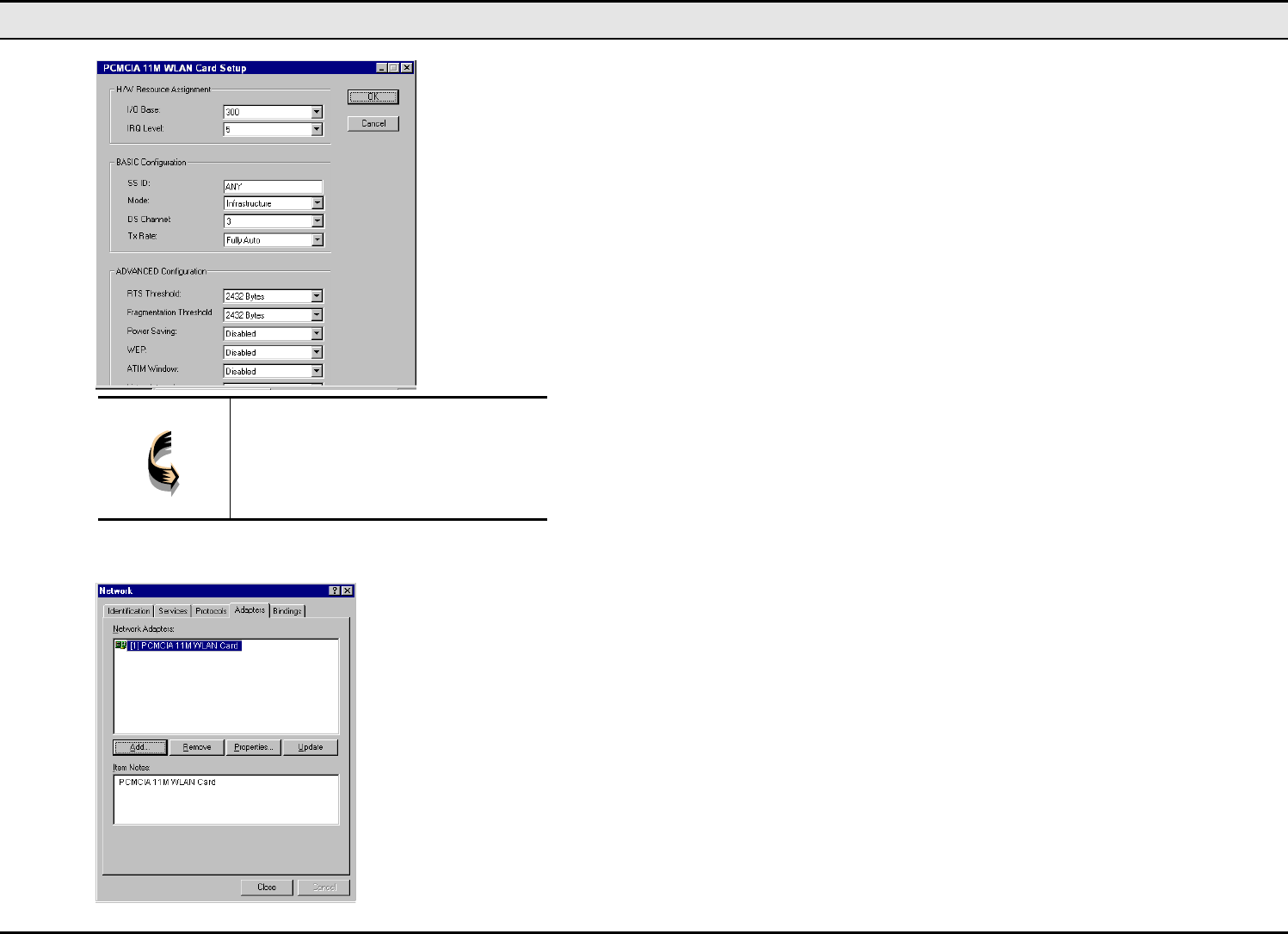
Wireless LAN card user manual
22
Note! You must select resources that are not
being used by another device; other-
wise, you will have a system conflict
error. In case of a system conflict error,
try another setting and continue.
8. Input the resources for the IRQ and I/O address ... Click OK to continue. Windows will configure the Wireless LAN card. You are returned to the Net-
work window.

—Driver installation for Windows and Linux
23
9. Click Close to exit the Network window. Windows NT 4.0 will bind the adapter with the network component and you will be prompted to restart the system.
When Windows NT is finished binding the adapter to the network component, you are prompted to restart the system.
10. Click Yes to finish the installation.
11. After you have rebooted the computer, system will start to install Wireless utility automatically. Please refer to procedures at Chapter 4.
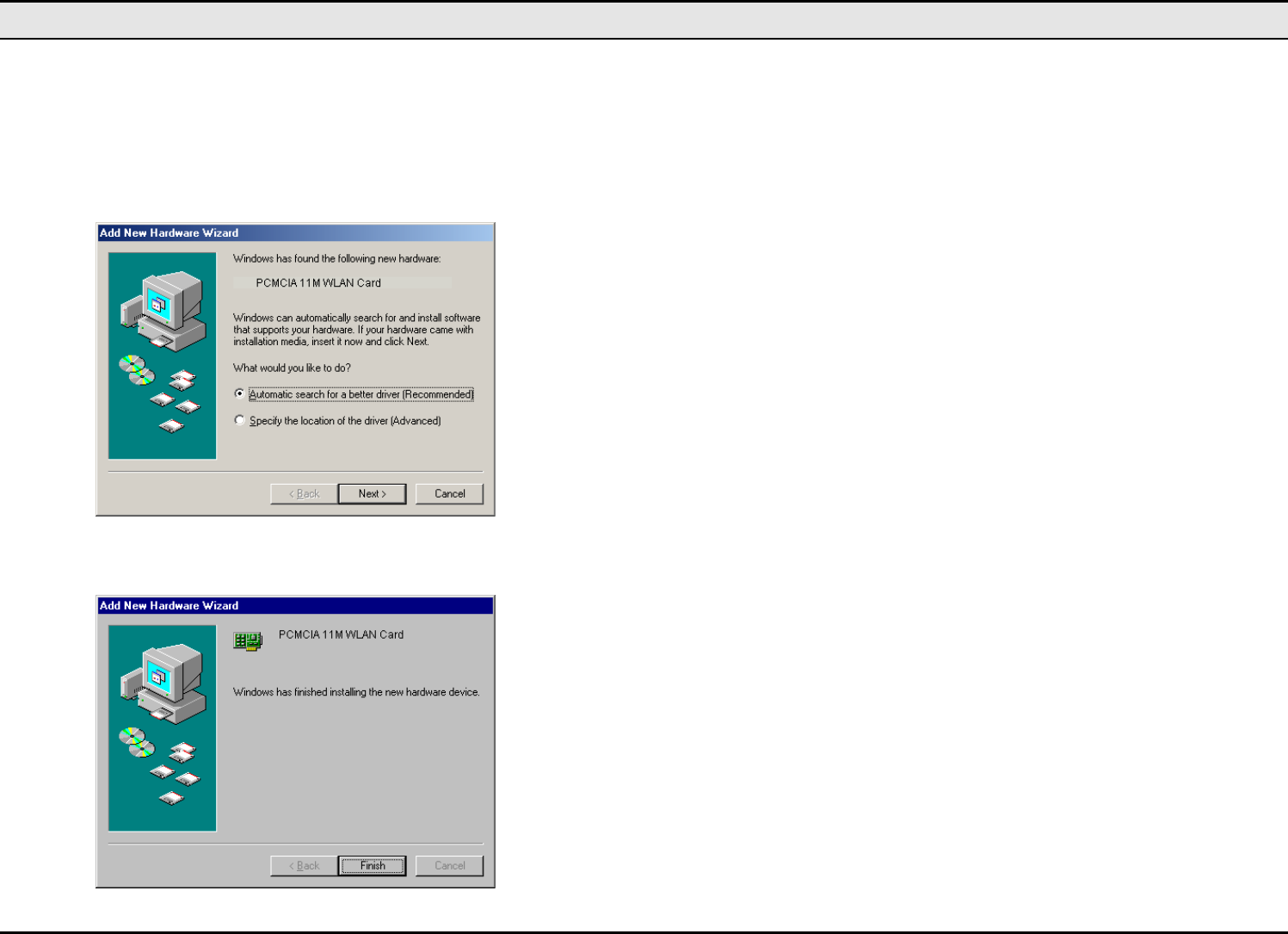
Wireless LAN card user manual
24
Driver Installation for Windows ME
Follow the steps below to install the Wireless LAN card drivers for Windows ME.
1. Insert the Wireless LAN card into an available PCMCIA slot on your notebook (refer to page 6 - Inserting the Wireless LAN card).
2. After Windows ME detects the Wireless LAN card, the Add New Hardware Wizard window appears:
3. Select Automatic search for a better driver (Recommended) and insert the driver disc into CD-ROM drive. Click Next to continue.
4. The system will find the setup files and follow the instruction of the setup file to copy drivers. After the drivers were copied, the following screen appears:
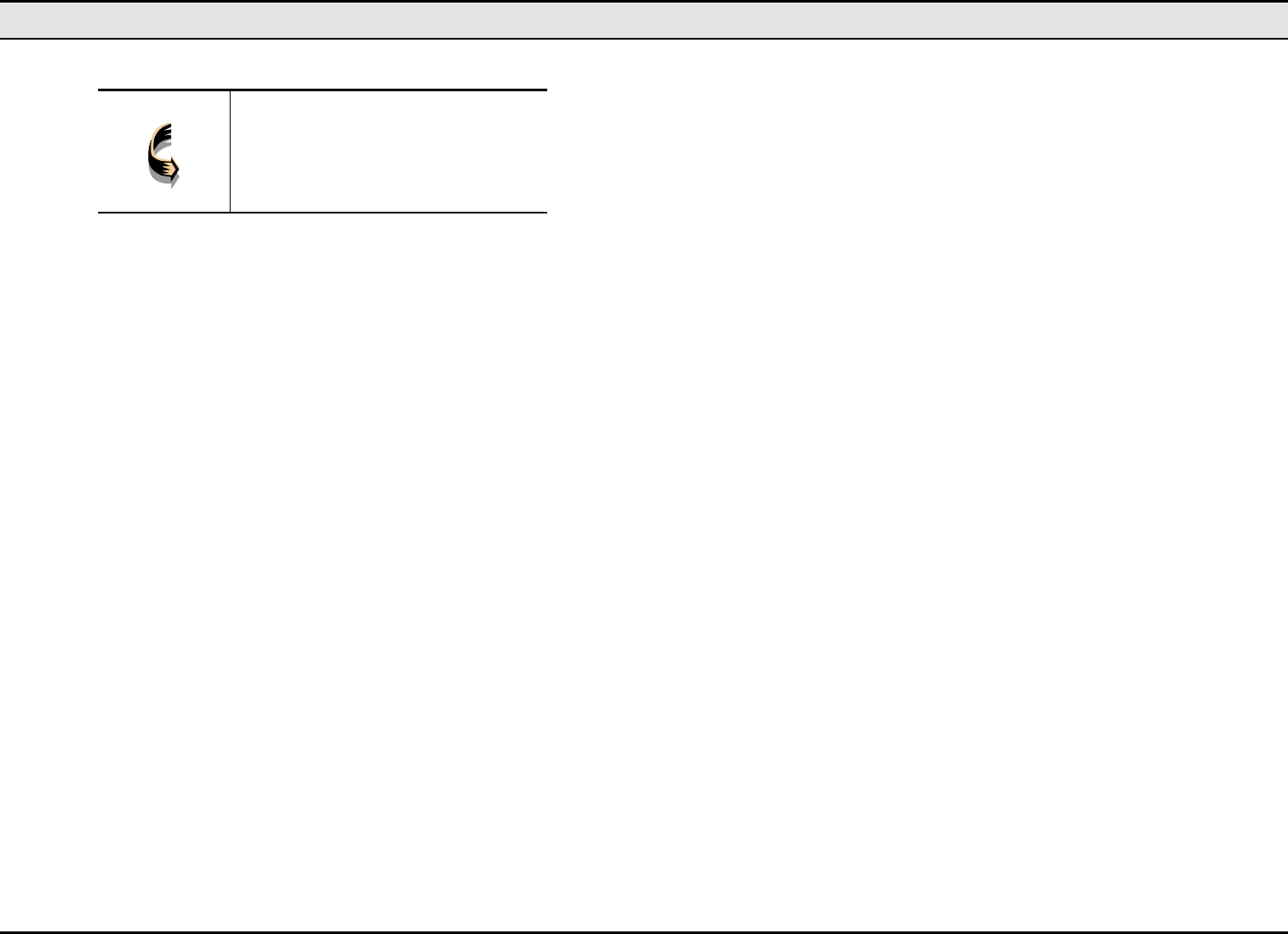
—Driver installation for Windows and Linux
25
5. Click Finish. You should reboot your system to finish the installation.
Note! Windows ME may need to copy re-
quired system files and will prompt you
to input the path to the files. Follow the
instructions on your screen, and then
click OK to continue.
After you have rebooted the computer, system will start to install Wireless utility automatically. Please refer to procedures at Chapter 4.

Wireless LAN card user manual
26
Driver installation for Linux
Follow the steps below to install the Wireless LAN card drivers (wlan-ng v0.1.6) for Linux.
Before Installing the Linux Drivers
Before you install the Linux wlan-ng v0.1.6 drivers, you need the PCMCIA module source code. If you do not have the source code, you can get it from the fol-
lowing URL:
ftp://hyper.stanford.edu/pub/pcmcia
After you have rebuilt and installed the PCMCIA module, edit /etc/pcmcia/network.opts to enable DHCP. In the DHCP setup, you can leave the fields empty. If
there is no DHCP server on your network, you might have to disable DHCP to use a static IP and then fill the fields in /etc/pcmcia/network.opts.
In Linux there is an 802.11b Access Point with which the station can be associated.

—Driver installation for Windows and Linux
27
Installation Procedure
1. Unpack the tgz file by typing the following line at the shell prompt, (assuming the shell prompt is >).
>gzip -cd wlan-ng-0.1.6.tgz | tar xvf -
2. Configure and install wlan v0.1.6. Be sure to configure the build as Station (STA)—do not choose Access Point (AP) because there is no firmware avail-
able that supports the AP function.
>cd wlan-ng-0.1.6
>make config
>make all
>make install
3. Edit /etc/pcmcia/wlan-ng.conf by adding the following lines to the bottom of the file.
card "PCMCIA 11M WLAN"
manfid 0x0274, 0x1601
bind "prism2_cs"
4. Edit /etc/pcmcia/wlan-ng.opts. The fields to edit are listed below:
dot11DesireSSID
APSSID
APCHANNEL
5. Restart your computer.
>shutdown -r now

Wireless LAN card user manual
28
When Linux is booting up, you will hear two high pitch beeps. This means that the driver has been loaded successfully. If you want to know if the card has con-
nected to an access point, see if the red ACT LED on the card is illuminated. When the ACT LED stops blinking, it means the card/station has been connected to
an access point.
This concludes Chapter 3. The next chapter covers installation of the wireless utility.
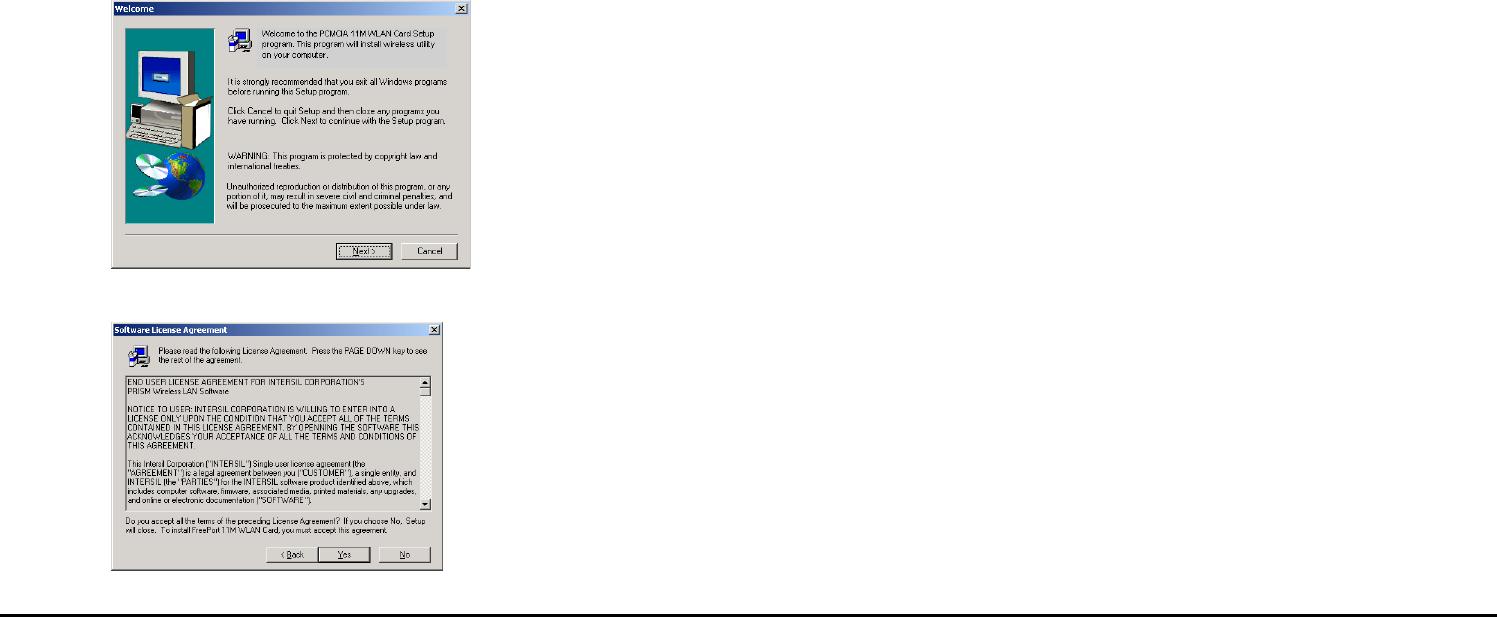
29
Chapter 4
Chapter 4Chapter 4
Chapter 4
Using the Wireless Utility
The following sections cover the Wireless LAN card utility installation and usage.
Installation in Windows
After you have installed the wireless LAN card driver and have rebooted the computer, system will start to install wireless utility automatically. Please follow the
steps below.
1. After you have rebooted the computer, the following screen appears:
2. Click Next. The following screen appears:
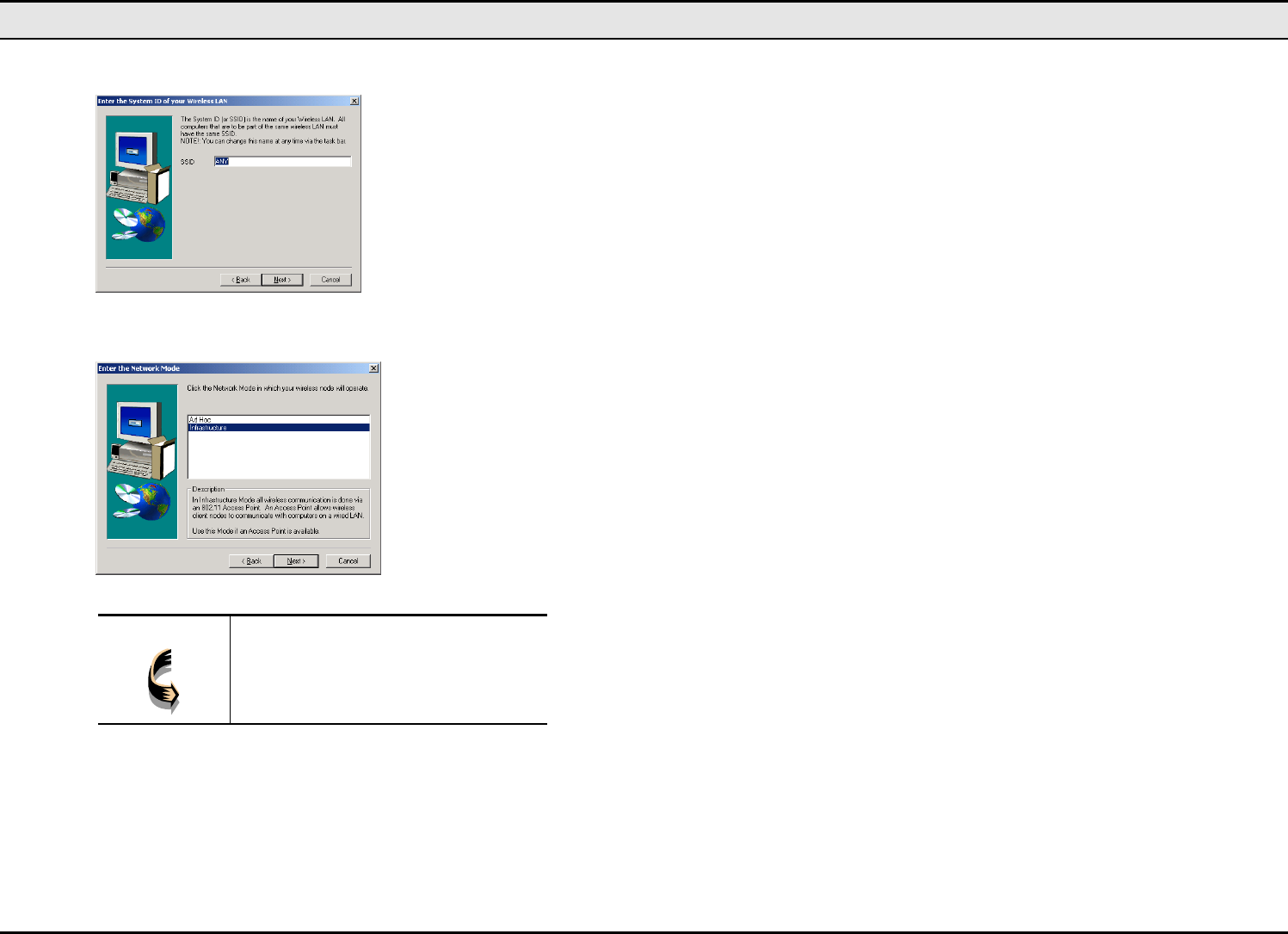
Wireless LAN card user manual
30
3. Read the End User License Agreement and click Yes. The following screen appears:
4. Type in a System ID name for your wireless LAN. This system ID identifies all computers in the wireless LAN. Then click Next. The following screen ap-
pears:
5. Choose the Network Mode for your wireless node.
Note! For information on which mode you
should select, refer to page 2, LAN
Modes.
6. Click Next. The following screen appears:
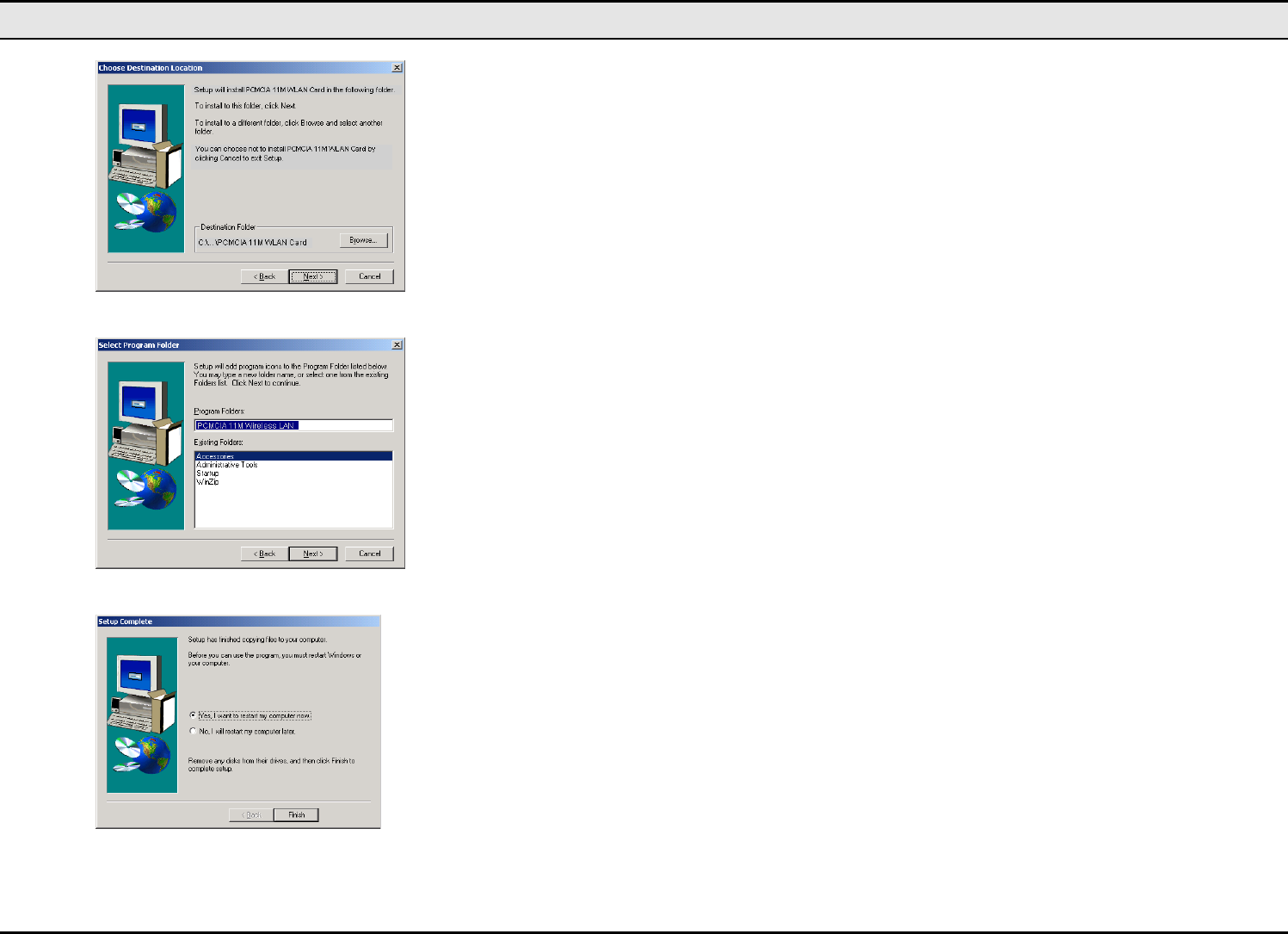
—Using the Wireless Utility
31
7. Select the default path for the wireless utility or browse to an alternate path. Then click Next. The following screen appears:
8. Type in a Program Folder name or select the default name and click Next. Setup installs the software and the following screen appears:
9. Click Finish to finish the utility installation.
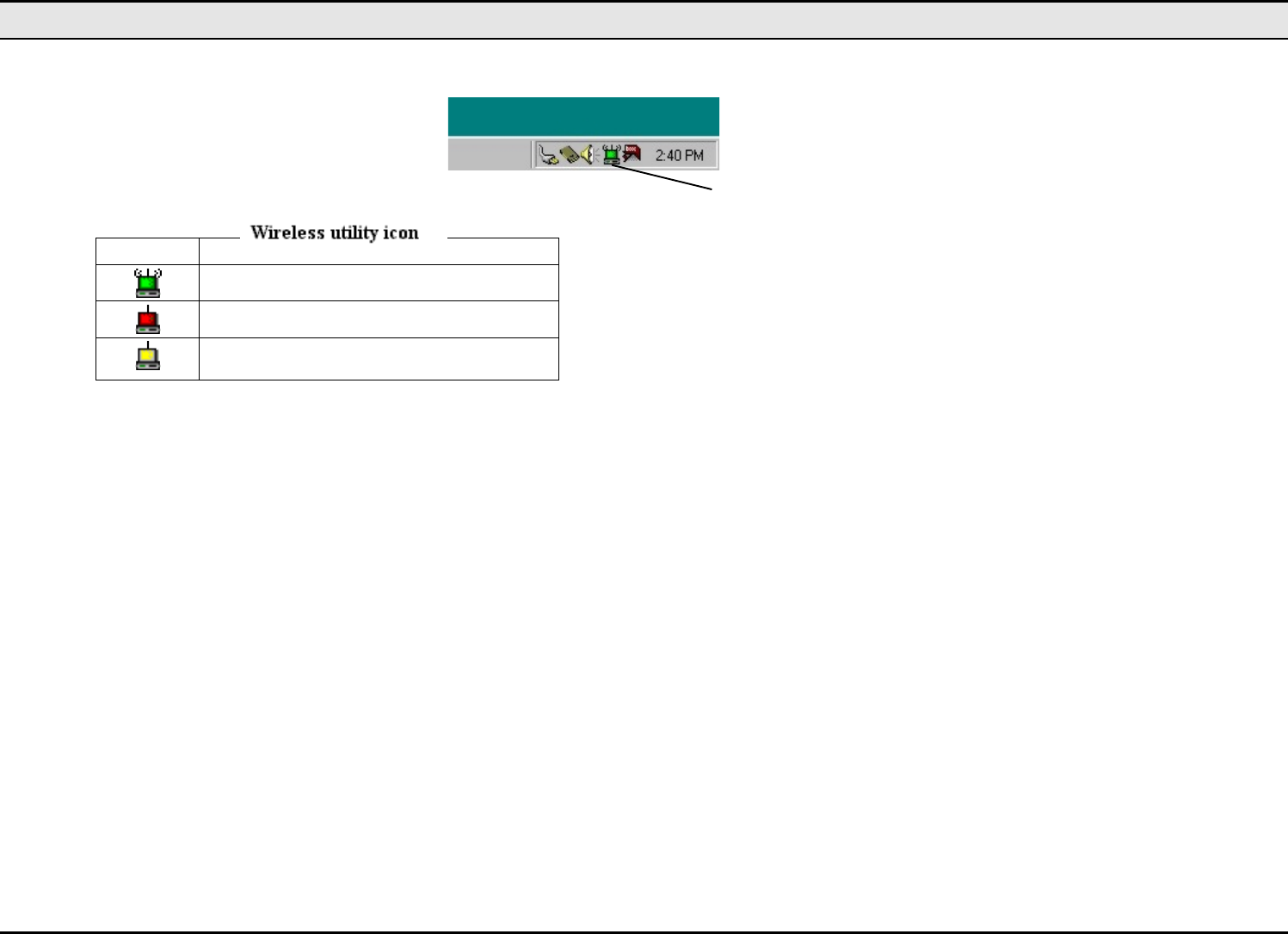
Wireless LAN card user manual
32
After you have installed the utility, you will see the wireless utility icon in the Windows taskbar:
FreePort utility icon
Icon Meaning
Green: indicates a connection is active.
Red: indicates no connection is active.
Yellow: indicates that the wireless LAN card is
looking for an available access point.
Double-click the icon to open the configuration utility.
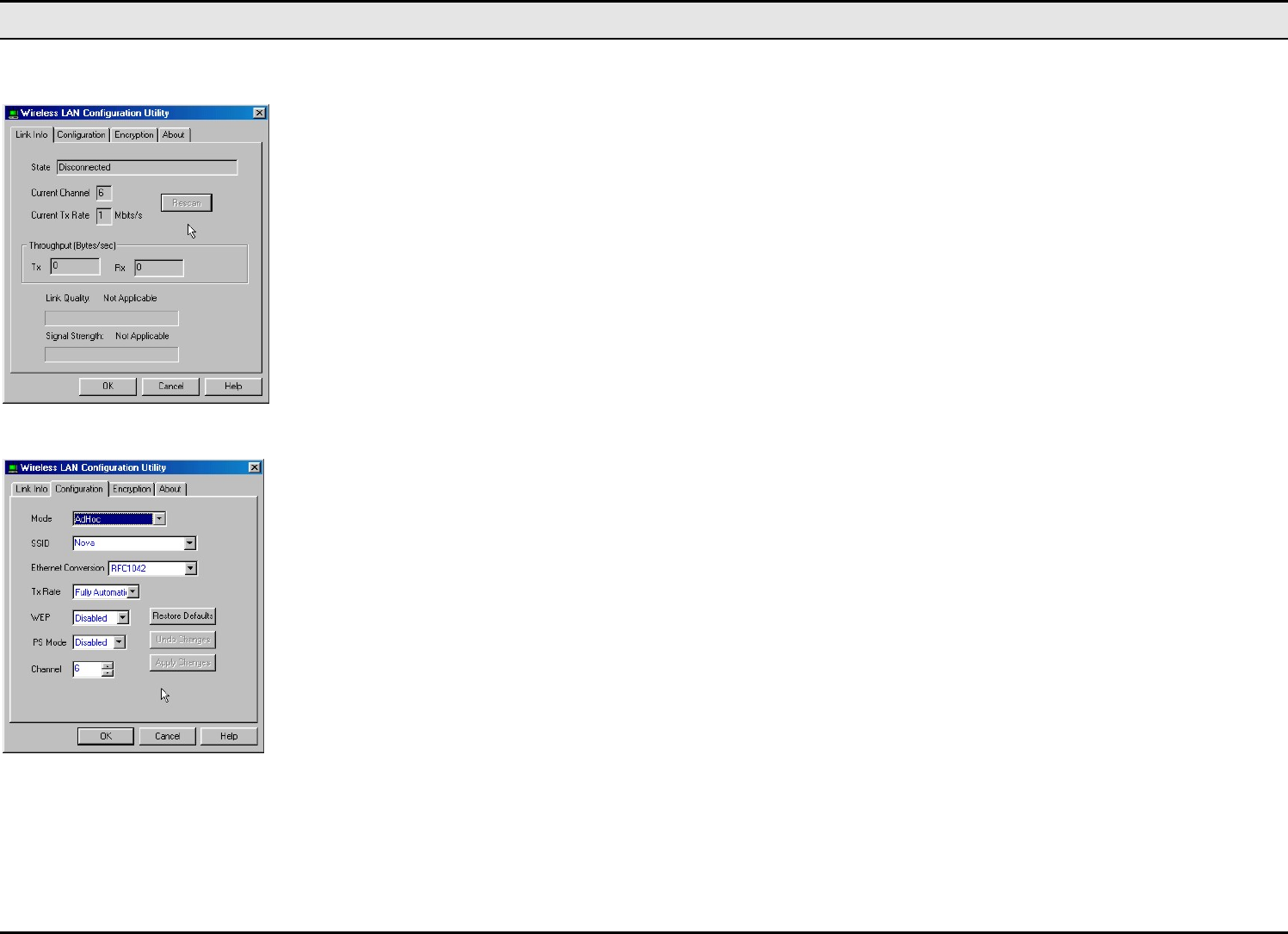
—Using the Wireless Utility
33
The following table describes the configuration utility:
State: displays the connection status.
Current Channel: displays the chan-
nel.
Current Tx Rate: displays the wire-
less bandwidth in megabits per
second.
Throughput: displays the transfer
and receive rates in bytes per second.
Link Quality: when connected to the
wired LAN, displays the connection
integrity.
Signal Strength: when connected to
the wired LAN, displays the signal
strength.
Note: Link quality and signal strength
are not available when using a peer-
to-peer connection.
Mode: displays the current LAN
mode, either AdHoc or Infrastructure.
SSID: displays a list of Service Set
Identifications.
Ethernet Conversion: displays a list
of Ethernet conversion protocols.
Tx Rate: displays a list of transfer
rates.
WEP: allows you to enable or disable
Wired Equivalency Privacy (WEP) for
encryption, with either 64- or 128-bit
encryption.
PS Mode: allows you to enable or
disable power saving mode.
Channel: enables you to select a
transmission channel.
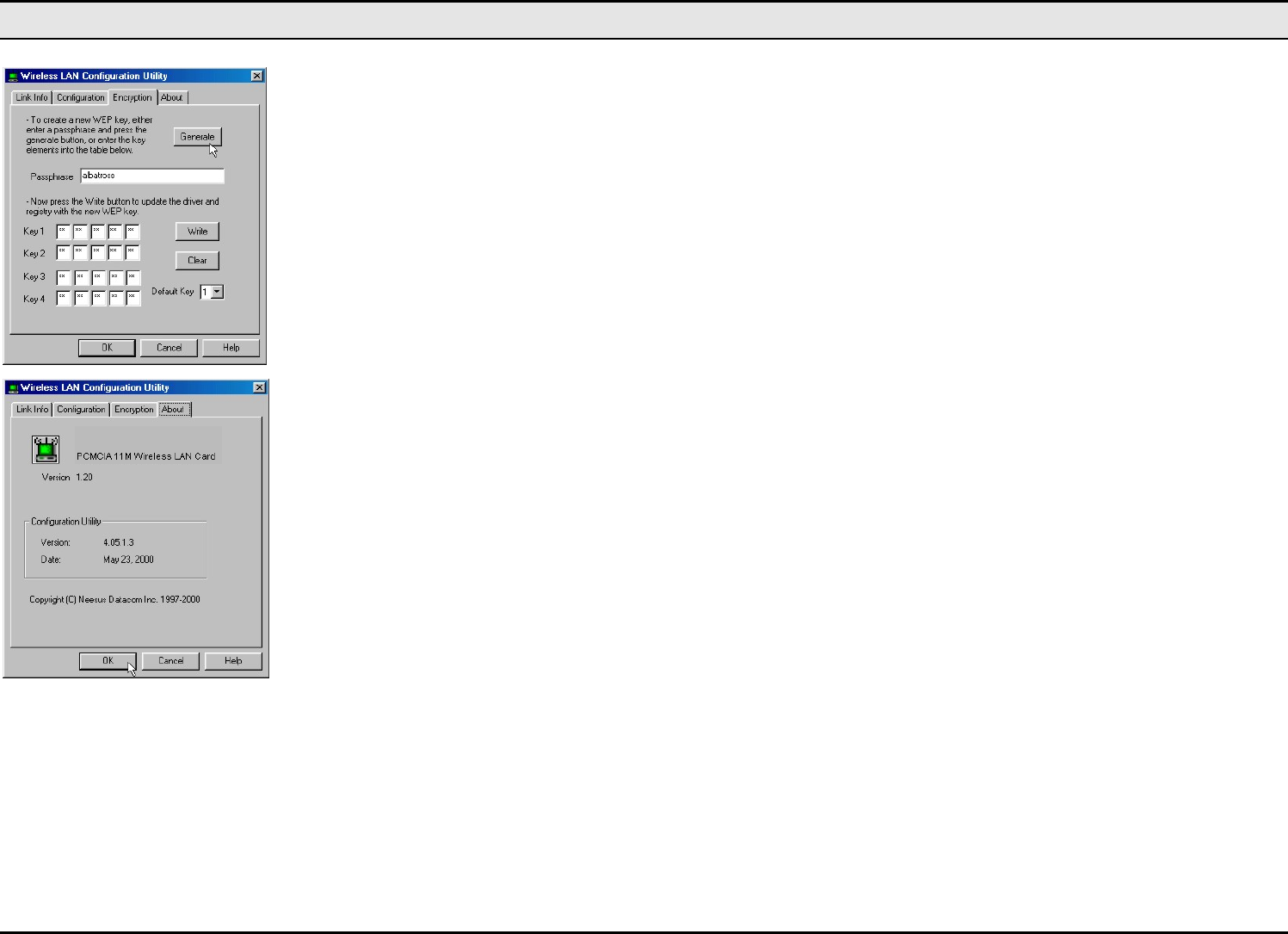
Wireless LAN card user manual
34
The Encryption window enables you
to create an encryption scheme for
Wireless LAN transmissions. Enter a
passphrase and press Generate to
automatically generate a 64- or 128-
bit key (selected from the WEP drop-
down menu in the Configuration
screen).
You can also manually enter a set of
values for each key.
Note: 128-bit encryption requires mo-
re system resources than 64-bit
encryption. Use 64-bit encryption for
better performance.
This screen displays the version
number of the Wireless LAN card and
the Configuration Utility.
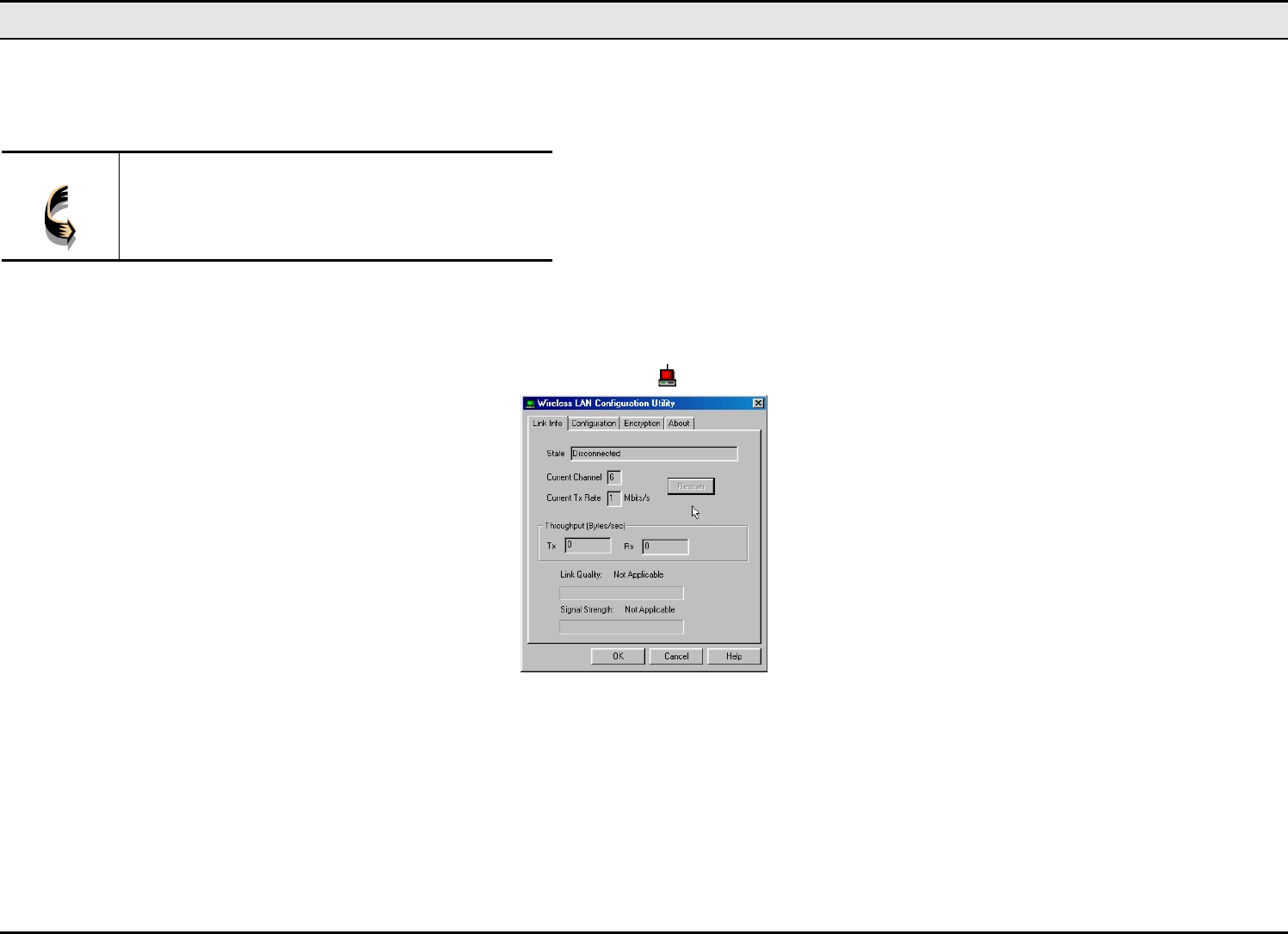
—Using the Wireless Utility
35
Using the Wireless Utility
The following example will help you set up a peer-to-peer connection with the Wireless LAN card.
Note! For information on connecting your wireless LAN card
to the LAN, contact your system administrator.
1. Insert a Wireless LAN card into the PCMCIA slots of two Notebook PCs.
2. Install the card drivers on both notebook computers (refer to Chapter 3).
3. Install the software on both notebook computers (refer to page 29).
4. After you have installed the software and rebooted, double-click the icon in the lower corner of your screen to open the configuration utility:
5. Click the Configuration tab:
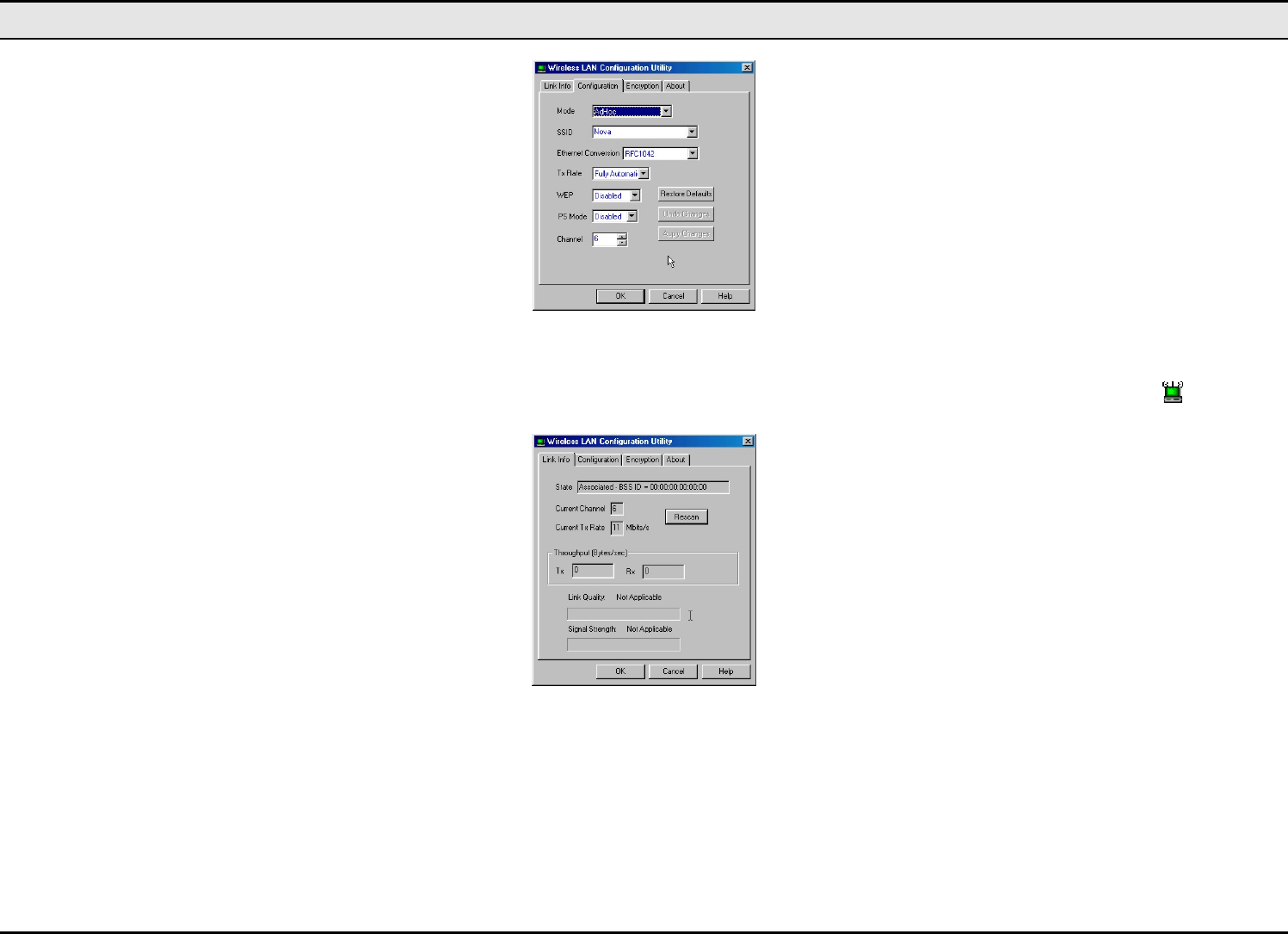
Wireless LAN card user manual
36
6. Select AdHoc from the Mode dropdown list. The SSID should be the same as the one that you entered when installing the software. Leave the other set-
tings at their default values.
7. Perform steps 1 through 3 on another notebook PC. When the two computers have connected via the Wireless LAN cards, the tray icon turns green and the Link
Info tab of the configuration utility shows an active connection:
8. After the connection has been established, double-click the Network Neighborhood icon on your desktop to view the two computers connected to the peer-
to-peer network:
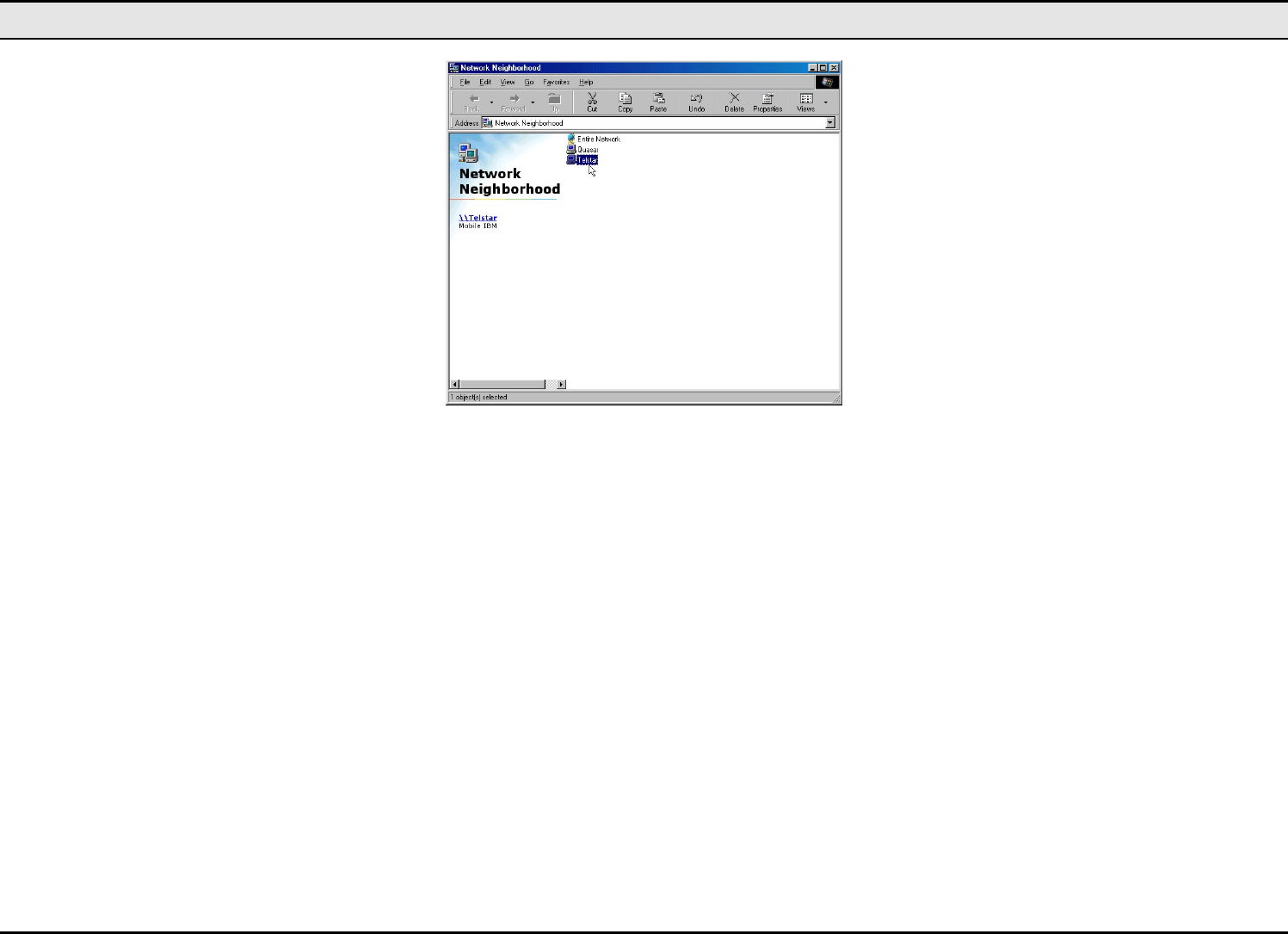
—Using the Wireless Utility
37

39
Appendix A
Appendix AAppendix A
Appendix A
Troubleshooting
Q&A
These guidelines give you tips to deal with some problems you may encounter while using the Wireless LAN card. If the problems remain unsolved, contact your
dealer for assistance.
Problem: Windows can not recognize the card.
Solution: Please check if PC Card support is installed. Double-click the PC Card icon on Control Panel. If PC Card support is not activated, you
should activate it now.
Problem: Ejecting the card from the PCMCIA socket hangs or reboots the computer.
Solution: To prevent this phenomenon from occurring, stop the card by using the PC Card tool in the Control Panel or the PC Card icon on the
taskbar before you remove the card.
Problem: The card cannot be detected when reinserted.
Cause: This is caused by certain unstable PCMCIA status lines when the card is removed and reinserted. The Windows 95/98 drivers may read an
incorrect status during this period of signal instability, and fail to detect the correct status of the card.
Solution: The card can be detected by clicking Refresh in Device Manager.
Question: What is the Microsoft digital signature?
Answer: Drivers that pass Microsoft Windows 2000 certification receive a digital signature file from Microsoft. The Wireless LAN card does not have
such a digital signature, however it is fully compatible with Windows 2000.
Question: The Wireless Utility icon on system tray is always red.
Answer: Please make sure that all clients have the same SSID. The SSID is case sensitive. And set all clients to the same wireless channel and
make sure you are within range of an Access Point or client.

Wireless LAN card user manual
40
Question: Can not connect to one of the clients in the network.
Answer: First of all, make sure that all clients are up and running with a green Wireless Utility icon. And please check your TCP/IP setup is correct
for your network.

41
Appendix B
Appendix BAppendix B
Appendix B
Specifications
Standards Compliance: IEEE802.11b WLAN Standard,
PCMCIA 2.1 and JEIDA 4.2 Standard
Socket Interface: 68-pin 16-bit PCMCIA socket connector
Card Size: PCMCIA extended Type II
Frequency: 2.4 to 2.4835GHz ( Industrial Scientific Medical
Band )
Antenna: Build in strip Antenna (internal)
Roaming: IEEE802.11 compliant
Data Rate: 11Mbps / 5.5Mbps / 2Mbps / 1Mbps
Modulation Technique: Direct Sequence Spread Spectrum
BPSK / QPSK / CCK
Coverage Area: Close Space : 50m @ 11Mbps,
80m @ 5.5Mbps or lower
Power: DC +3.3V /+5V, 240mA (3.3V)
Output Power: 16dBm (typical)
Receiver Sensitivity: -83dBm Min.
Operating Environment: Temperature: 0o to 55oC
Humidity: 10% to 90%
Dimensions: 115 x 54 x 7.5mm
Weight: 47g